OMAN: 10-DAYS IN A MIDDLE EAST OASIS
Oman had been sitting at the top of my travel bucket list for five years. The far-off country in the Middle East seemed to be the stuff of dreams – oasis canyons, vast dunes, exotic souqs and desert castles. Distance was always my excuse for not visiting Oman, but this year I decided it was time to make the journey. I planned a 10-day trip to Muscat and its surrounds, and it exceeded all expectations. Our trip started in Muscat, and we went as far south as Wahiba Sands, and then east out to the desert castles of Nizwa. Below is my complete guide to this part of Oman, filled with the best wadis, beaches, forts, island day trips, souks, travel tips, Google Map pins and more.
This post contains affiliate links. When you click these links I may get a small commission that won’t cost you anything, but it does help me run this website.

Found a turquoise oasis on the hike out to Wadi Shab.
WHEN TO VISIT OMAN
- OCTOBER – MARCH (high season) – Even in high season, Oman is not busy compared to other travel destinations. Temperatures are comfortable this time of the year as you avoid the sweltering heat of the scorching summer months. I visited in November and found the weather to be prefect, and the tourist crowds were minimal, even on a national holiday.
- APRIL-MAY (shoulder season) – Temperatures around Muscat start to rise this time of the year as the highs slowly creep into the high 90s.
- JUNE-SEPTEMBER (low season) – Temperatures sore to unbearable temperatures during the summer months, best to avoid visiting this time of the year.
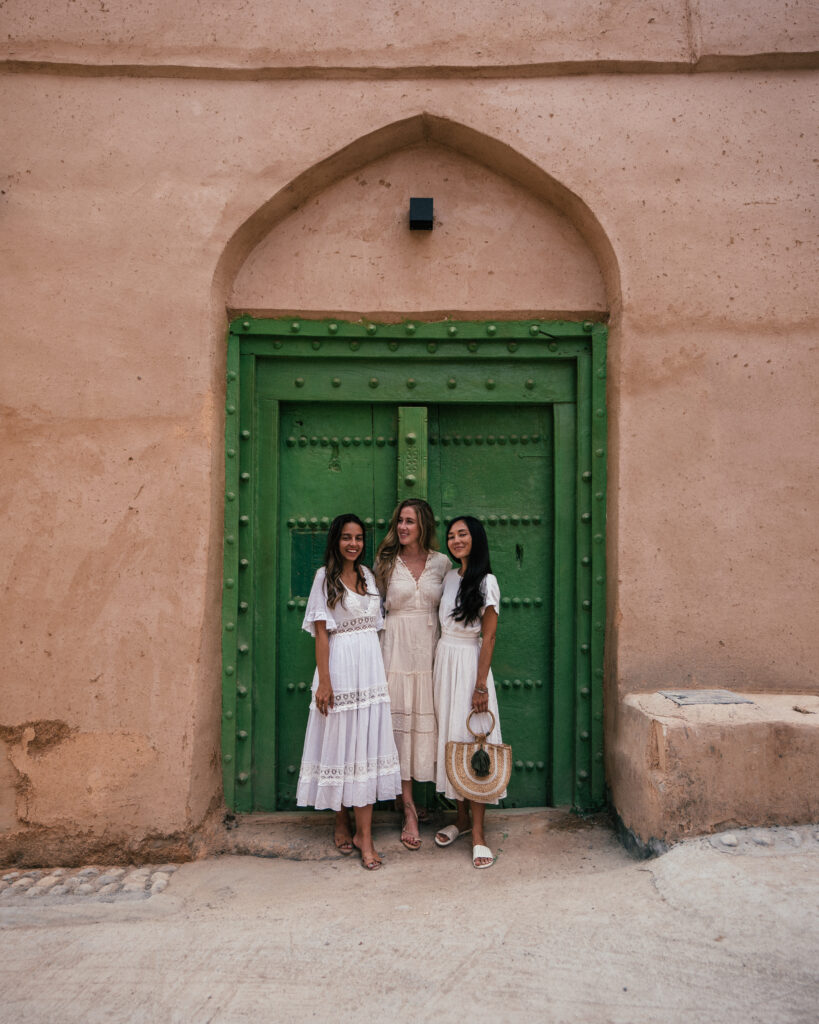
Traveling with my ladies Catarina Mello and Michelle Harlpern.
HOW MANY DAYS IN OMAN?
10 DAYS. There is a lot to see in Oman, but if your focus is Muscat and its surrounds (similar to my trip), then 10 days is ideal. It’s enough time to experience the best beaches, wadis, hikes, islands, castles and villages. Distances aren’t too bad, and with a car you can cover a lot of ground in a little over a week.
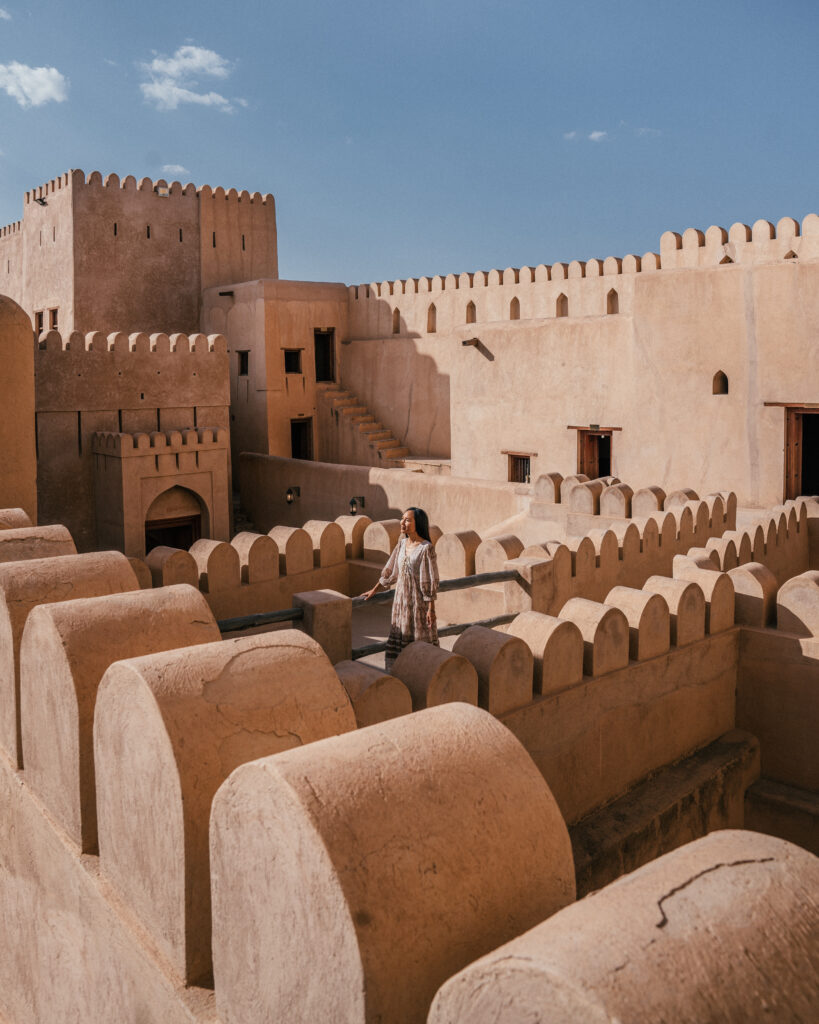
The Nizwa Fort is a 17th century castle located two hours from Muscat. Outfit details: Daughters of India dress linked here.
OMAN TRAVEL TIPS
- CURRENCY – The local currency is the Oman Rial. There are ATM’s at the airport for cash withdrawal upon arrival. I used my credit card for most of the trip – the hotels, souqs, restaurants and cafes all take credit card. Cash is only necessary for tipping, and a few random small expenses like the ferry crossing at Wadi Shab.
- SIM CARDS – I found Oman to be a pretty expensive country for tourists. However, the e-SIM cards are very affordable! I highly recommend picking one up at the airport in the Arrivals lobby. I used Ooredoo, and paid 5 OMR ($13) for 8 GB for one week.
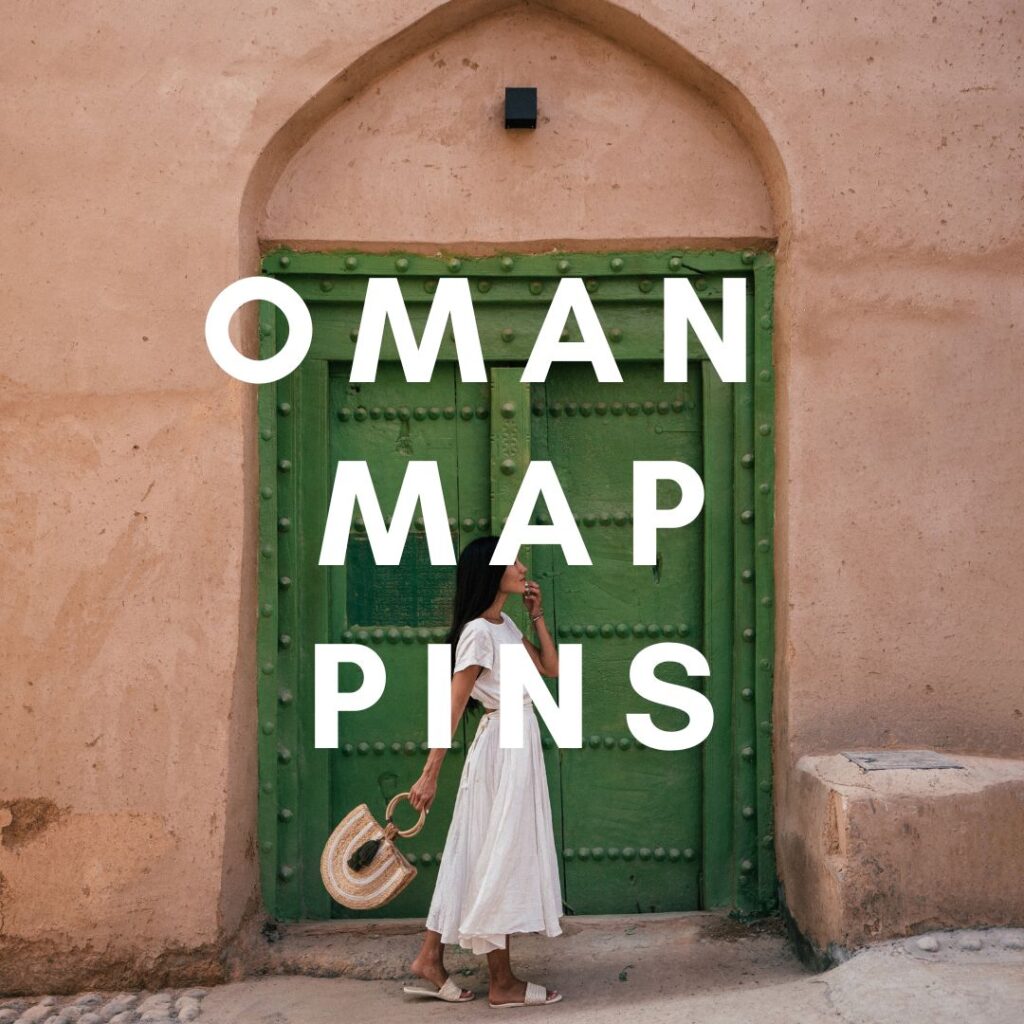
My 100 Google Map pins for Oman are available here.
OMAN GOOGLE MAP PINS
Oman is one of my all-time favorite adventures, and I’m sharing 100 of my Google map pins from destinations across the country with you guys here. The map is savable to your Google account, and easy to use for trip planning and navigation once on the ground in Oman.
Map pins include:
- must-visit forts, desert castles, mosques, souks, viewpoints
- hotels
- cafes, restaurants
- wadis, beaches, off shore islands, remote coves
- boat rental companies
- photo and travel tips for several of these locations
Destinations included in the map: Al Sharqiyah region, Jebel Akhdar, Muscat, Nizwa, Wahiba Sands
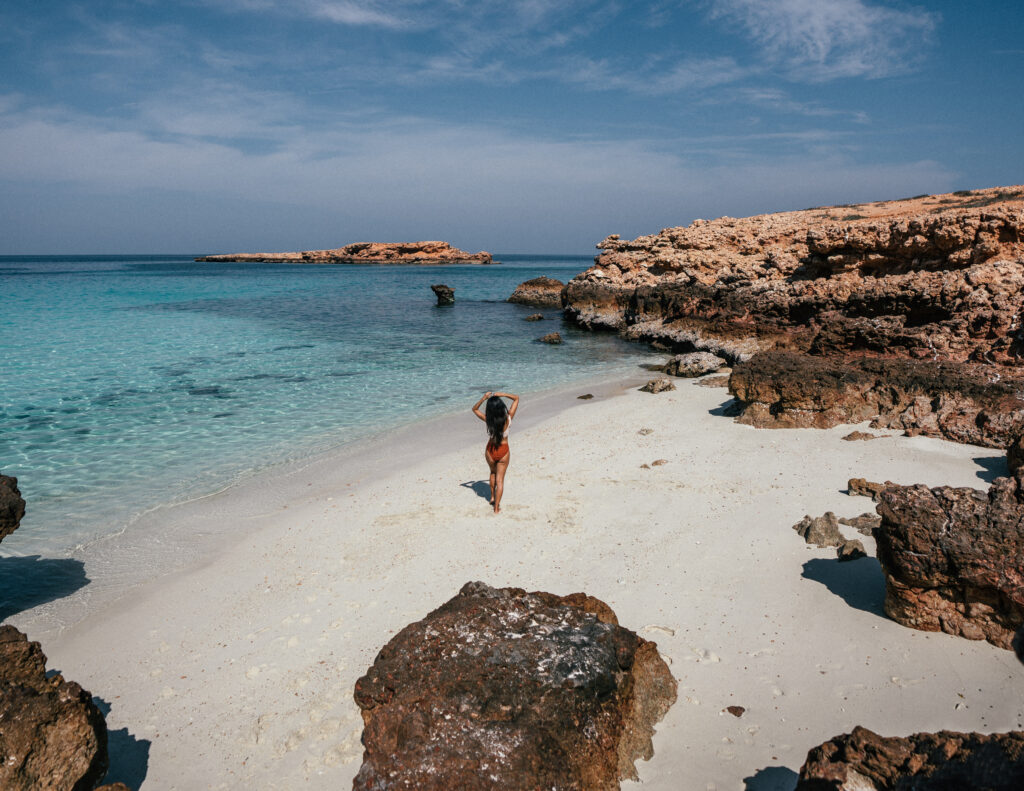
Amazing day trip out to the Daymaniyat Islands.
MUSCAT
days 1-2
Most visitors begin and end their Oman adventures in Muscat. The capital city borders the Gulf of Oman, and its central location makes it a convenient home base for day trips around the region. I suggest a minimum of two days in Muscat to explore the beaches, the souqs, the mosques and day trip to the Daymaniyat Islands. Also, if hotel creature comforts are important to you, I recommend staying in Muscat for as long as possible and visiting the surrounding regions by day trip. The best hotel accommodations are in Muscat, and up in Jebel Akhdar.
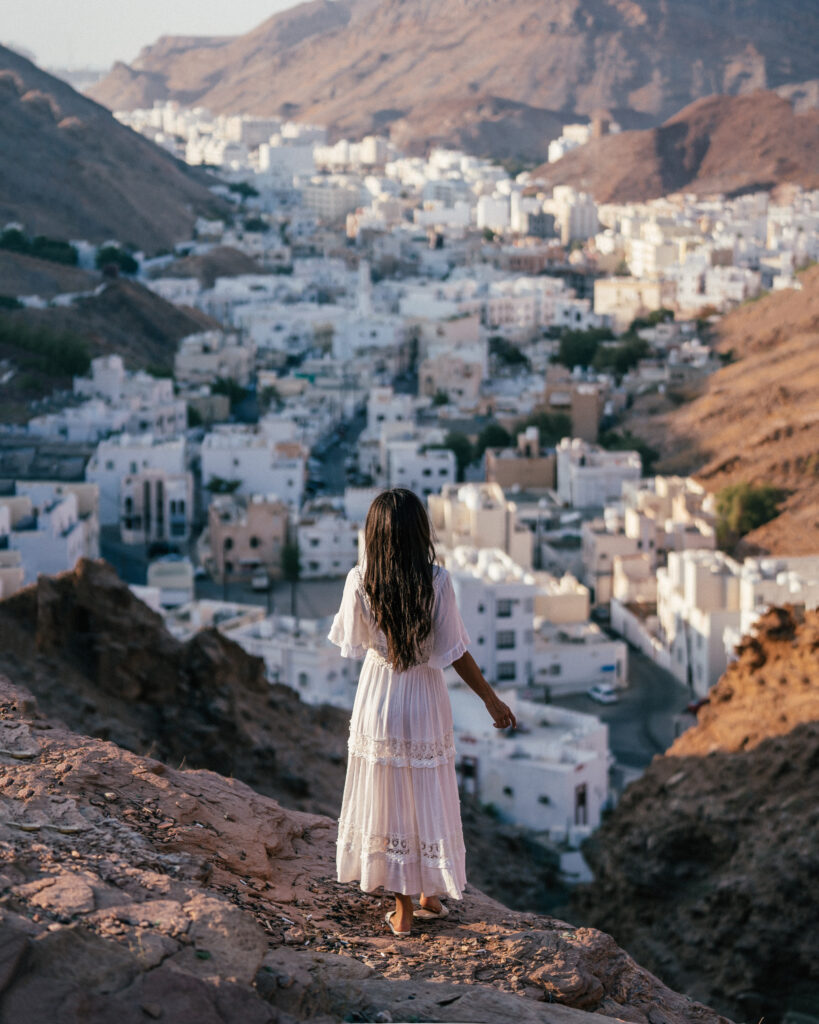
Golden Hour views over Muscat. Outfit details: Fortunate One Store dress linked here and Tkees flats linked here.
EXPLORE MUSCAT
BANDAR AL KHAIRAN
A beautiful stretch of coastline along Muscat’s west coast, home to incredible turquoise inlets that boast shallow clear waters. The stunning beaches are perfect for hiking, swimming, snorkeling and sweeping views. Drive time from Muscat is approximately 45 minutes.
MUSCAT VIEWPOINT
If you’re looking for a pretty viewpoint in Muscat, this is the one. This gem sits on an unmarked pull-off along Yiti Road overlooking a picturesque white-washed neighborhood at the base of sloping brown cliffs. Location on Google Maps is “Yiti Round Point of View.”
MUTTRAH SOUQS
The city’s vibrant indoor souqs are located on the Muscat waterfront. Merchants in the historic bazaar sell a variety of goods including spices, antiques, tea sets, lanterns and more. The souqs are bustling, but non-aggressive.
ROYAL OPERA HOUSE
The city’s hub of arts and culture hosts an array of performances including ballet, jazz, opera and world music, but the structure is also a beautiful architectural sight for tourists to visit. The grand cubic building is a marvel of glistening white marble, soaring archways and stunning arcades.
SULTAN QABOOS MOSQUE
The largest mosque in Oman sits in the heart of Muscat, home to minarets, ornate courtyards, mosaics, prayer halls and beautifully manicured gardens. The mosque is one of the prettiest sights in the capital city, and a must-visit. Women must be covered head to ankles – there are abayas and scarves available to rent at the entrance. Note that tourists hours are very specific (8 AM-11 AM, and possibly closed on Fridays), so plan accordingly.
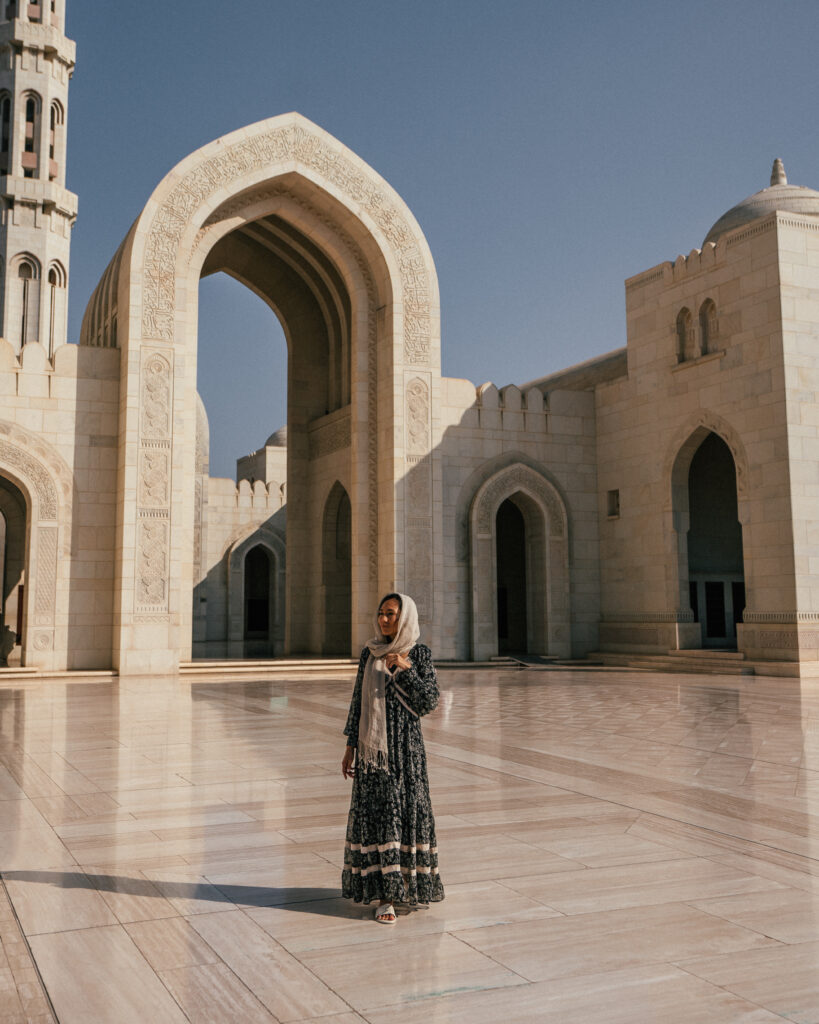
Sultan Qaboos Mosque.
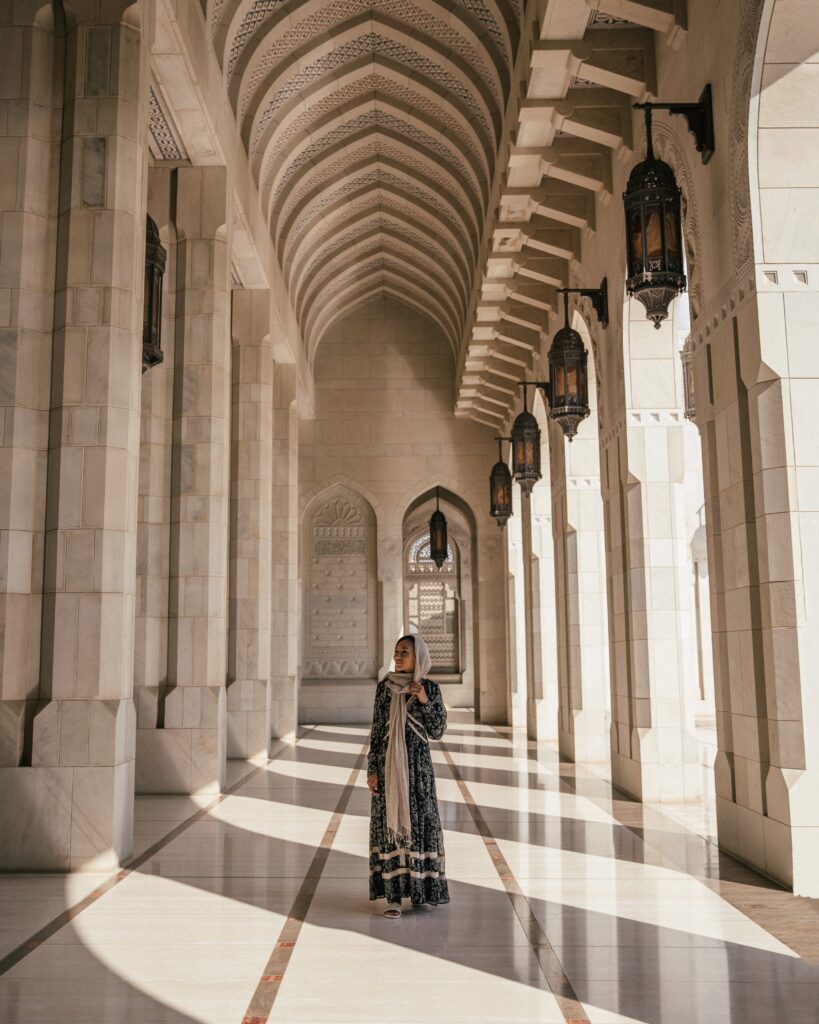
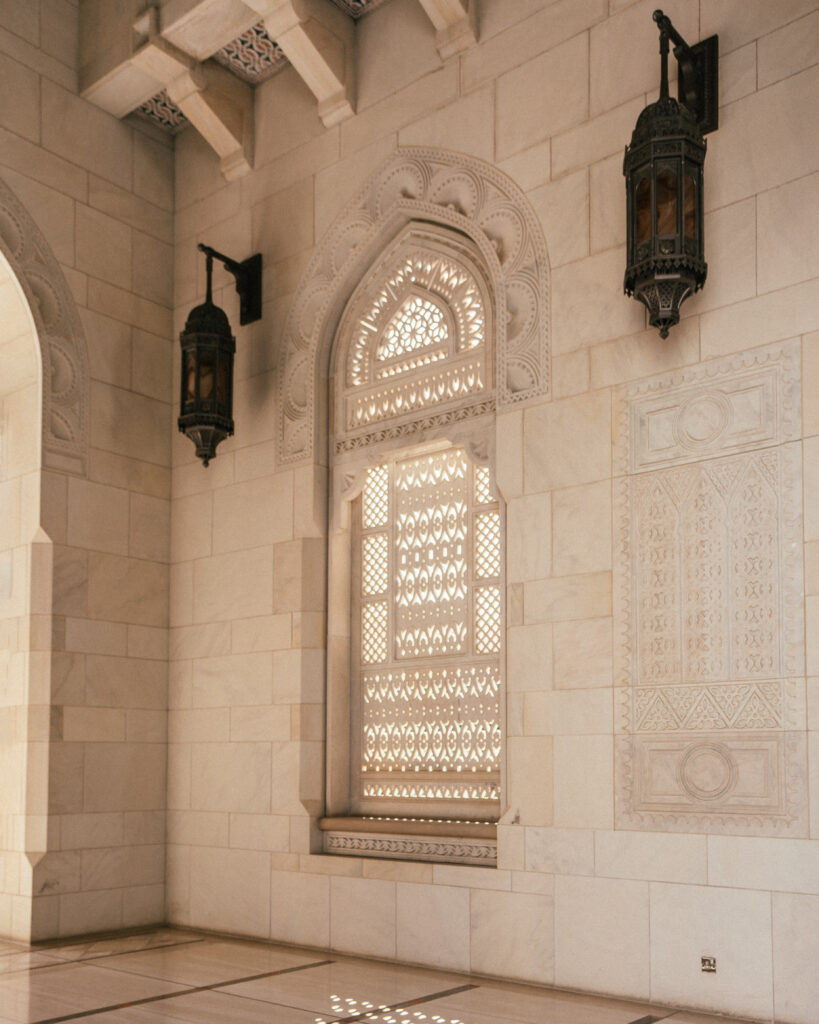
Tourists are limited to morning visits, so plan your trip to the mosque accordingly.
WHERE TO STAY IN MUSCAT
AL BUSTAN PALACE, A RITZ-CARLTON HOTEL
Originally built for Sultan Qaboos, Ritz Carlton’s Al Bustan Palace certainly feels fit for royalty. The property is its own private oasis, located at the base of the Al Hajar Mountains. Rooms are comfortable, albeit a bit dated, but the palace exteriors boast an exquisite space filled with Islamic archways, marble floors, soaring dome ceilings and a stunning spa that looks straight out of Arabian Nights.
Centrally located five-star resort that sits on a lovely stretch of Muscat coastline. The Chedi Muscat offers more than 150 decadent rooms and villas, minimalist in design, but completely modern and elegant. A little r&r is a must, as the resort lays claim to the longest infinity pool in the Middle East. It runs straight out to the gulf, lined with dozens of plush, gray sunbeds.
Beautiful five-star property located on a stunning stretch of Muscat coast between the Al Hajar mountains and the gulf. Jumeirah Muscat Bay is a modern property that houses more than 200 rooms, restaurants, a spa, private beach and ocean facing pools.
Located on the same stretch of coast as Jumeirah Muscat Bay, the beautiful Shangri-La Al Husn is the loveliest hotel option in Muscat. The resort sits on a spectacular private bay surrounded by dramatic cliffs that give way to sea caves and inlets. A 30-minute drive from central Muscat, the property has all the feels of a secluded oasis – a dreamy setting filled with ornate archways, palm-lined courtyards, wood carved doorways, infinity pools and pinkish hues. Shangri-La Al Husn offers a variety of rooms and suites, many with views over the gulf.
If your jam is a modern stay filled with bright colors, lights and party vibes, look no further than W Muscat. The resort’s location is one of its highlights, situated on the bustling Shatti Al Qurum Beach, and a short drive from the city’s main tourist attractions. Guests enjoy a full-service spa, rooftop bar, pools and nearly 300 rooms and suites.
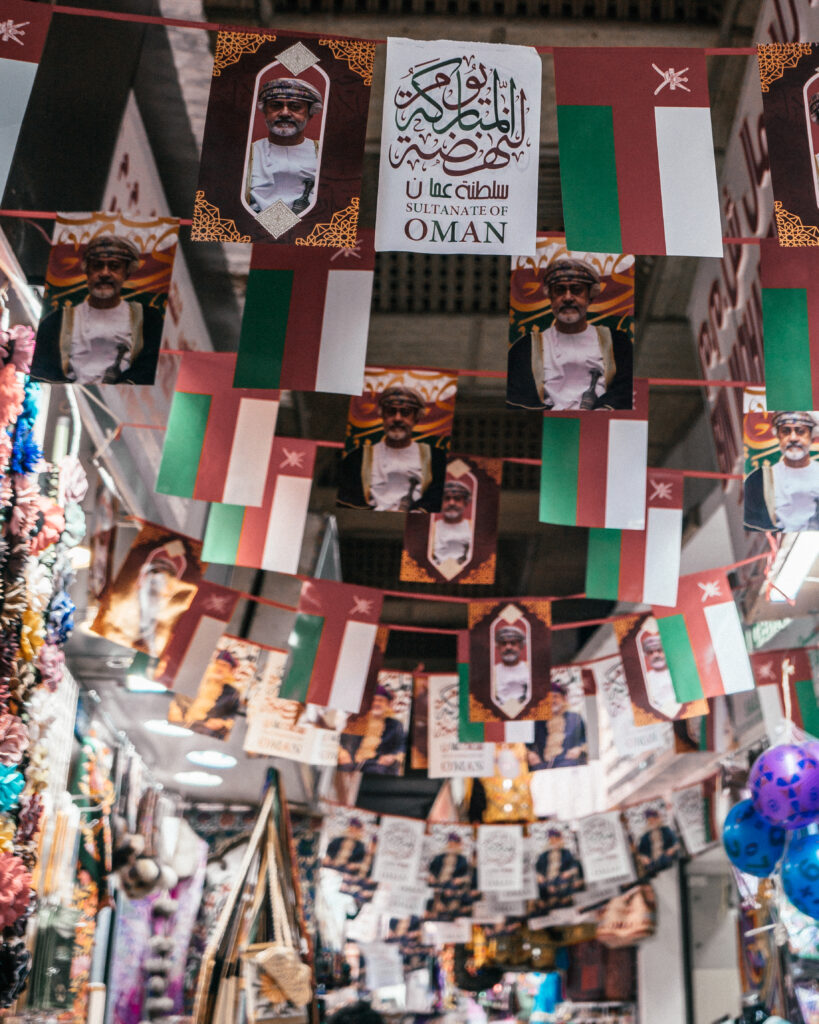
Omani flags line the Muttrah Souqs.
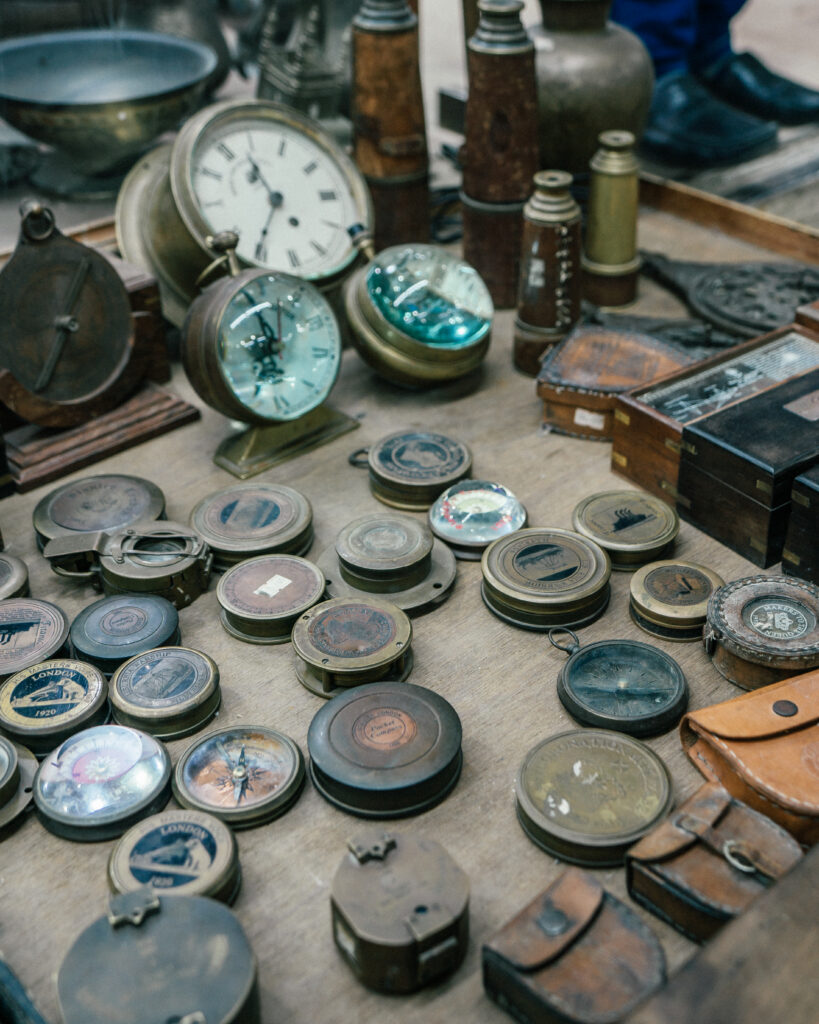
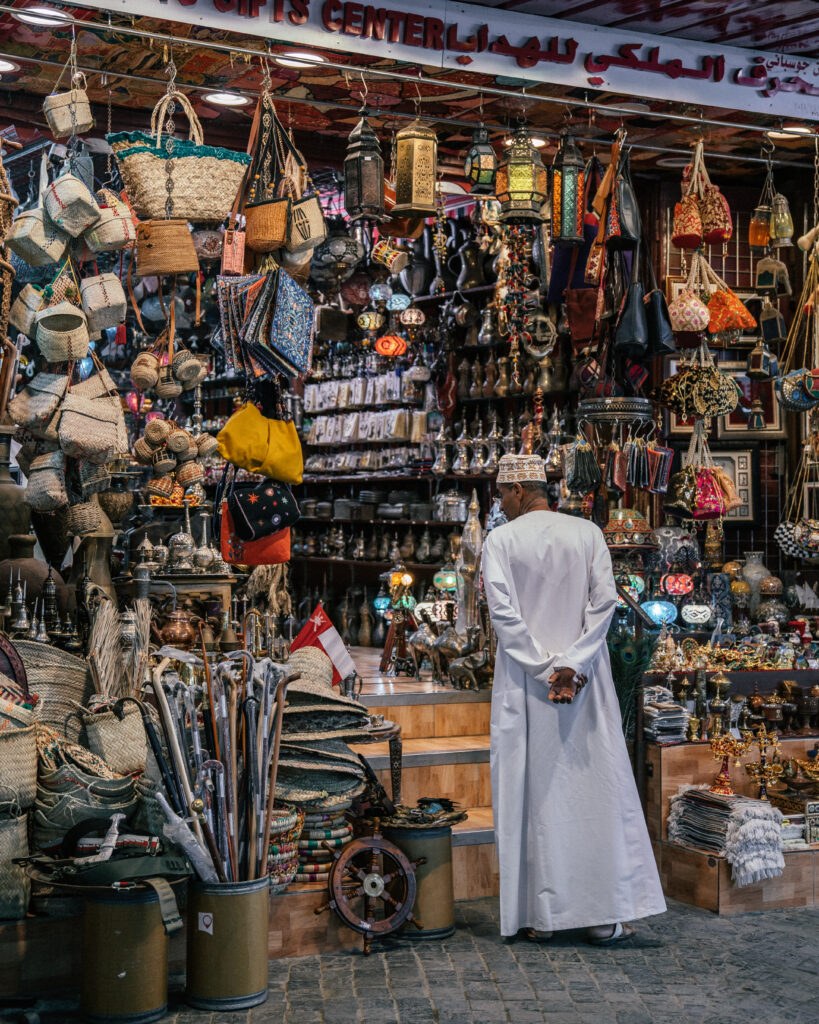
We felt calm and safe inside the souqs – the atmosphere isn’t aggressive at all.
MUSCAT RESTAURANTS
BAIT AL LUBAN
Bait Al Luban sits on Muscat’s bustling Mutrah Corniche and serves a variety of traditional Omani dishes including sambusa, katchori, soups, meats, curries and mixed grilled seafood. I recommend floor seating at the front of the restaurant – dark wood tables with bright pink and blue floor cushions.
THE PAVILION
Upscale beachfront dining option located inside the Al Bustan Palace. You can opt for an over-the-top brunch with stunning waterfront views, or an elegant evening dinner over artfully plated fresh seafood, meats and raws.
TOKYO TARO
Delicious sushi option in Muscat that serves a range of Japanese dishes including udon noodles, tempuras, soba, katsu, gyoza and sushi.
TURKISH HOUSE
Popular local spot that serves traditional Turkish favorites – hummus, labana, salads, kababs, oven grilled meats and fresh seafood straight from the Omani water including shrimp, lobster, calamari and king fish.
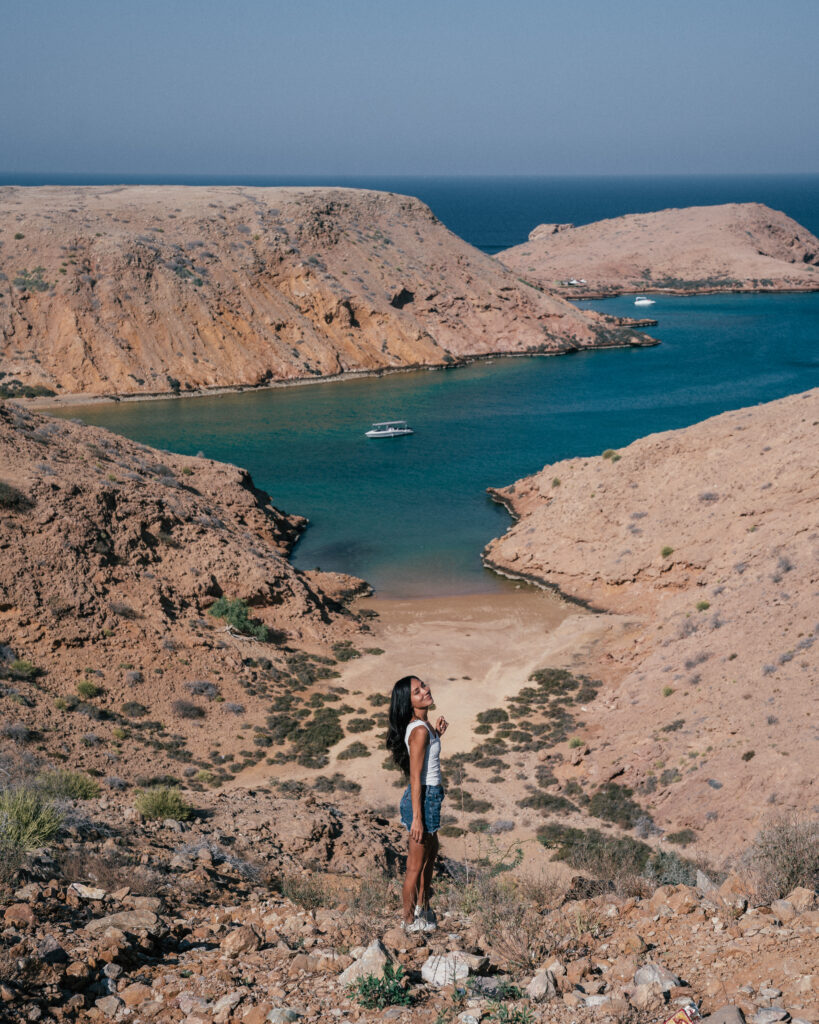
An epic hike down for a beach day at Bandar Al Khairan.
DAYMANIYAT ISLANDS
day 3
A day trip out to the Daymaniyat Islands is an absolute must while in Muscat. The pristine, calm waters have all the sparkles of the Maldives, but this collection of nine tiny islands is a mere 30-minute boat ride from the capital city’s harbor. While overnight camping is possible, we visited by day trip, and it was plenty of time for swimming, snorkeling and mini-hikes on the islands.
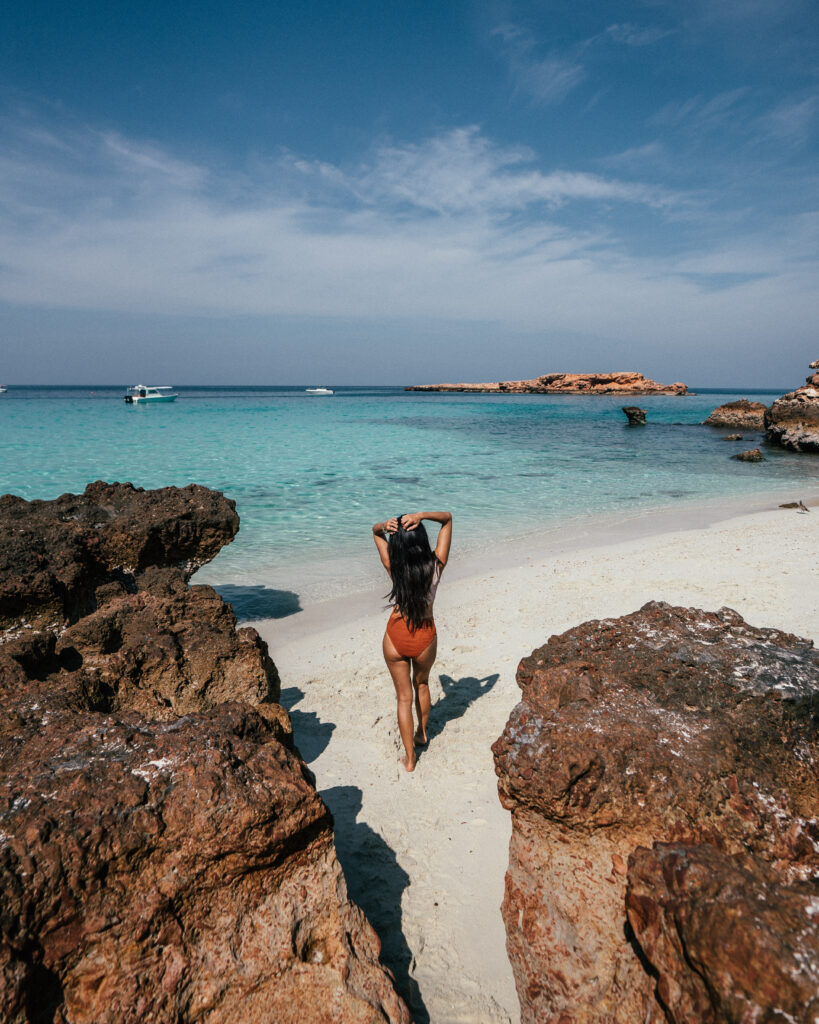
A remote paradise awaits, and it’s only a 30-minute boat ride away from Muscat.
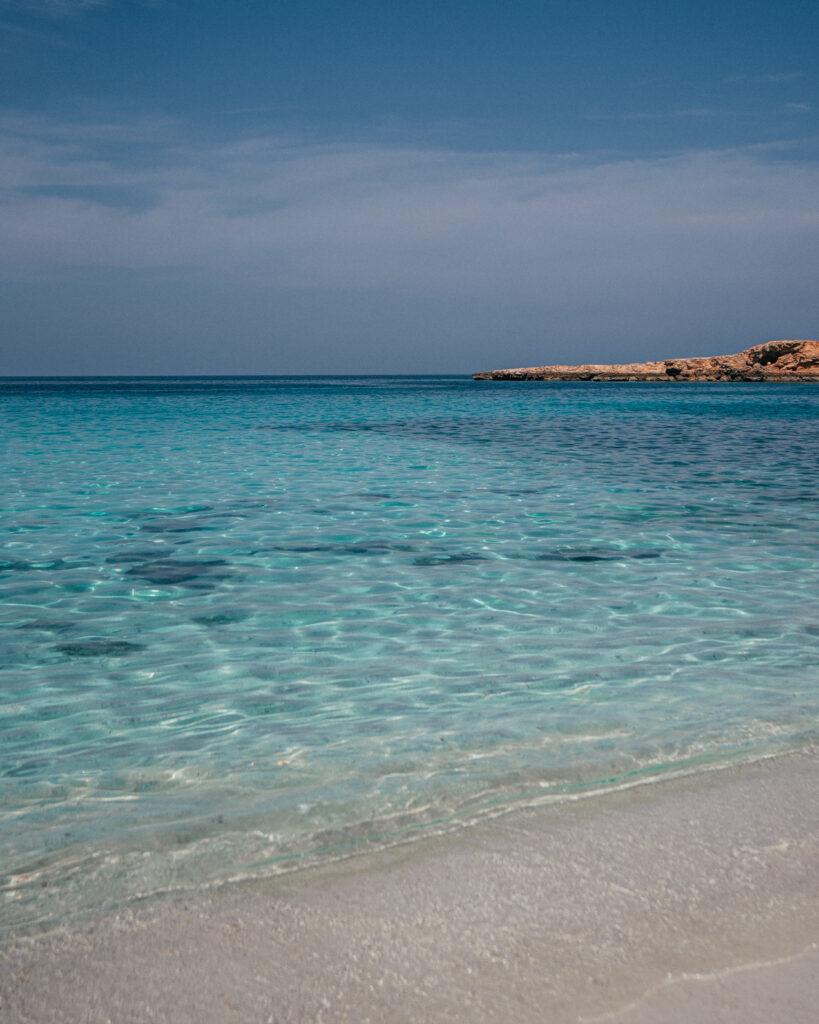
The Daymaniyat Islands is made up of nine tiny islands in the Gulf of Oman.
EXPLORE THE DAYMANIYAT ISLANDS
The dive sites out at the Daymaniyat Islands are pristine, thanks to the low visitor count. Whale sharks are plentiful during the summer months, and we snorkeled one site where a cluster of 15 turtles were feeding on the reef below us (and not another boat or tourist in sight).
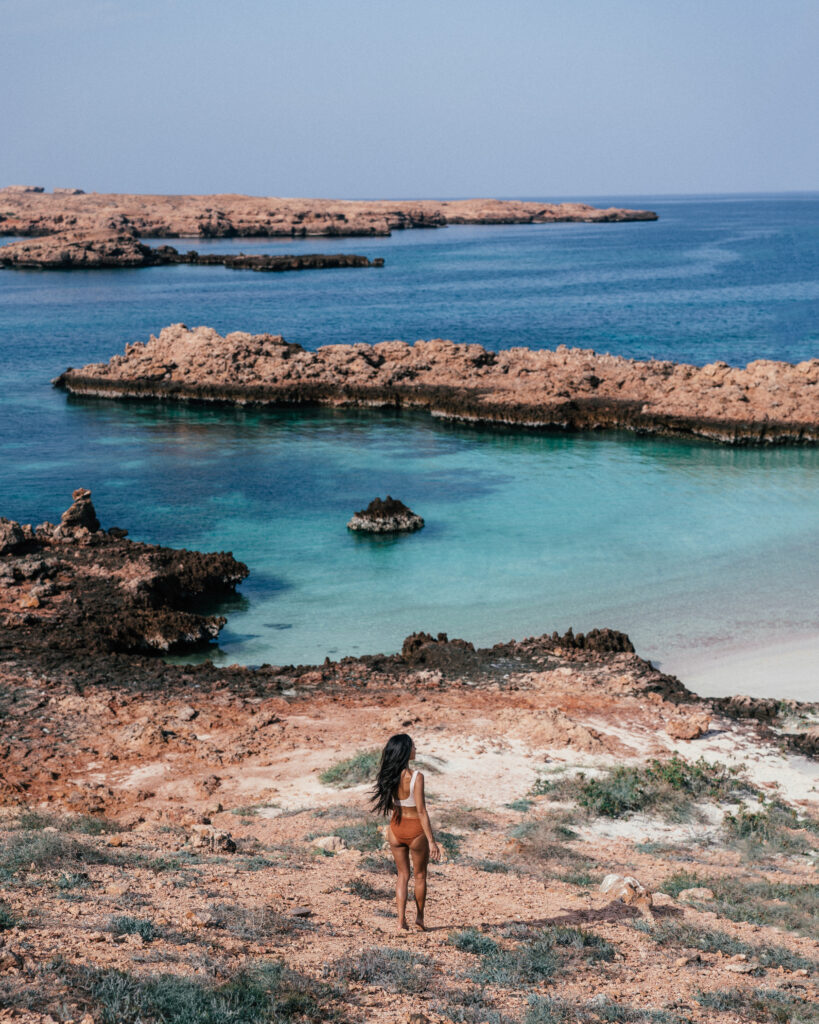
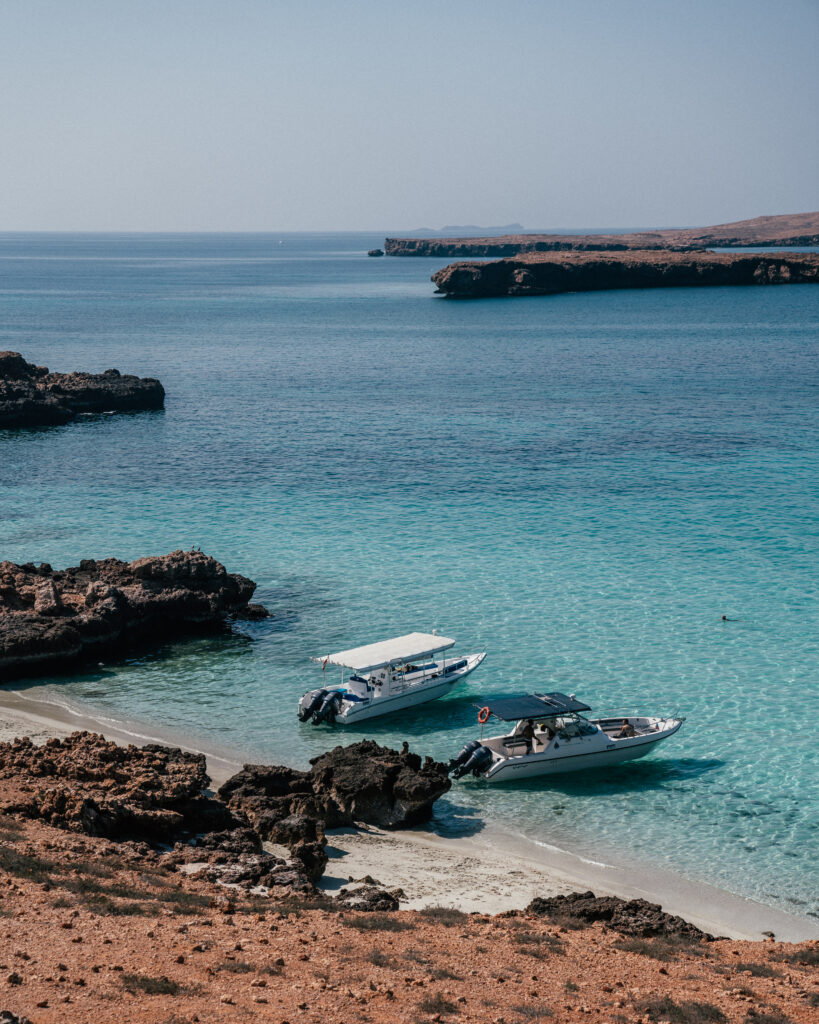
There are group tours that visit the islands, but we booked a private boat for our visit.
GET TO THE DAYMANIYAT ISLANDS
Group tours are the most popular way to visit the islands, but we booked a private boat through Marmar Boat Tours for flexibility and freedom. The islands feel untouristed, a rare find in this era of travel. We visited on a Friday that happened to be the country’s biggest national holiday, and we only saw a couple of small boats the entire day.
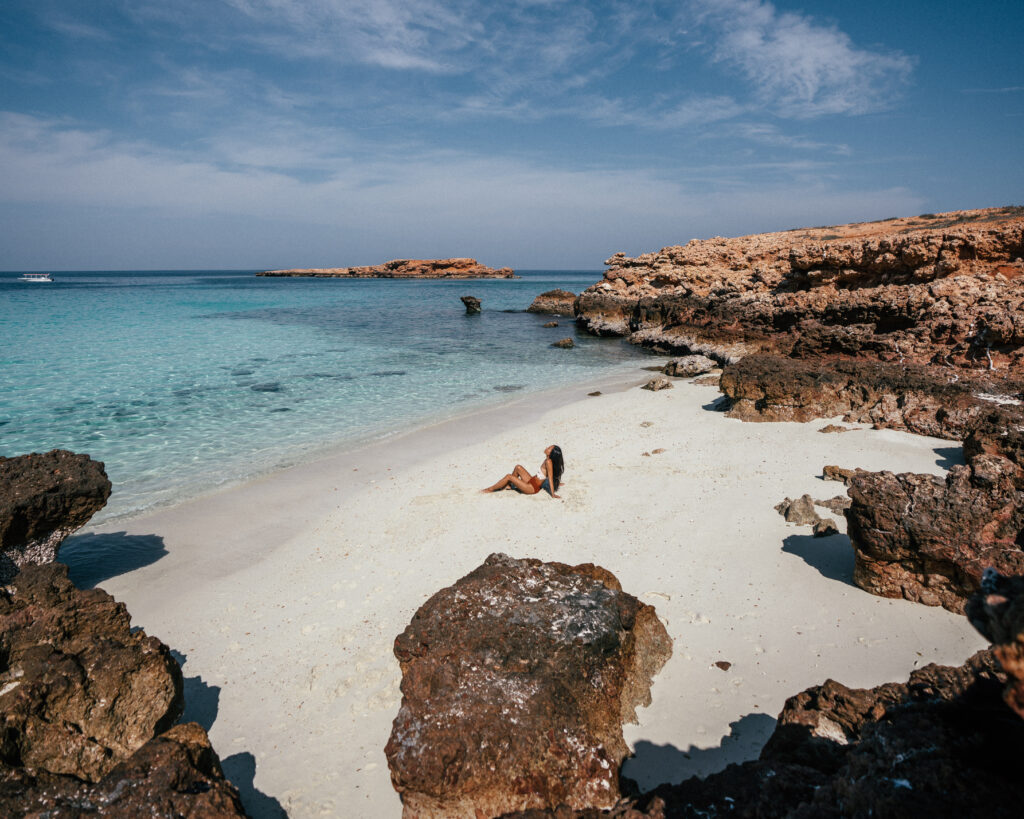
Soft white sand + shallow warm waters = an Omani paradise.
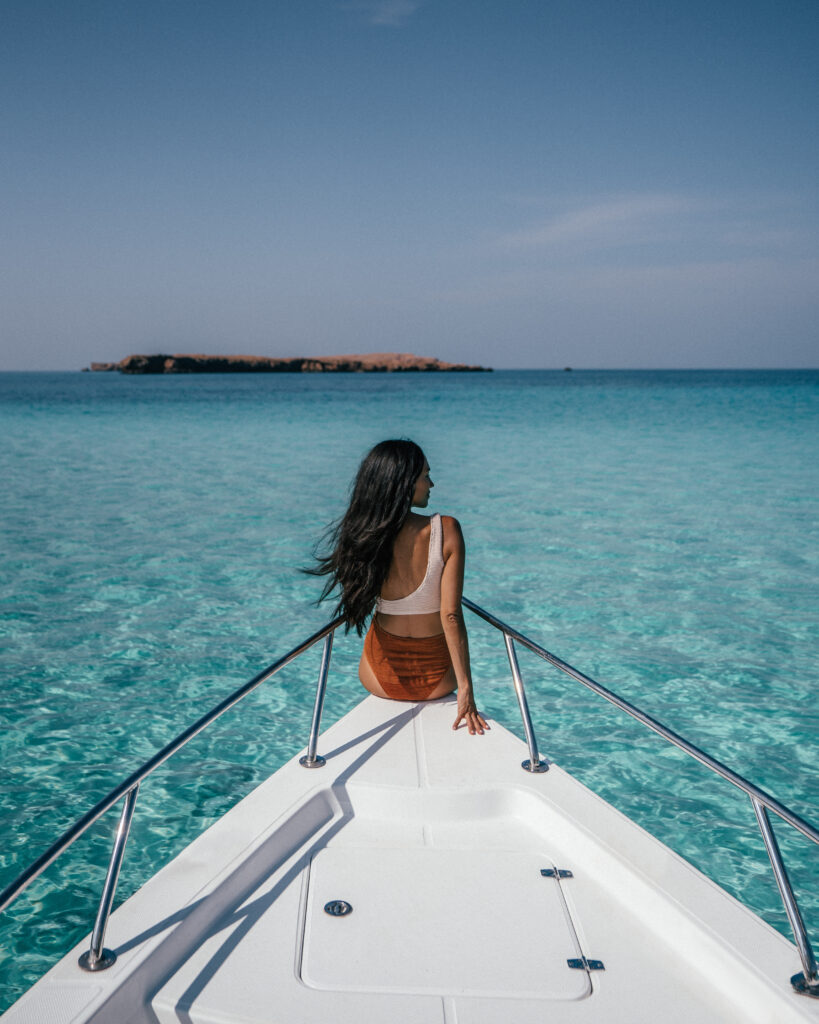
We booked our private boat through Marmar Boat Tours – highly recommend!
THE WADIS & SUR
day 4-5
One of the country’s most unique attractions is the collection of wadis and sinkholes that stretch from Dibab down to Sur along the Gulf of Oman coastline. The wadis are narrow rocky gorges, typically filled with clear turquoise water, ideal for hiking, swimming and adventure. Most of these gems can be visited as a series of day trips from Muscat, or alternatively you can book a no-frills hotel in the region to save on drive time.
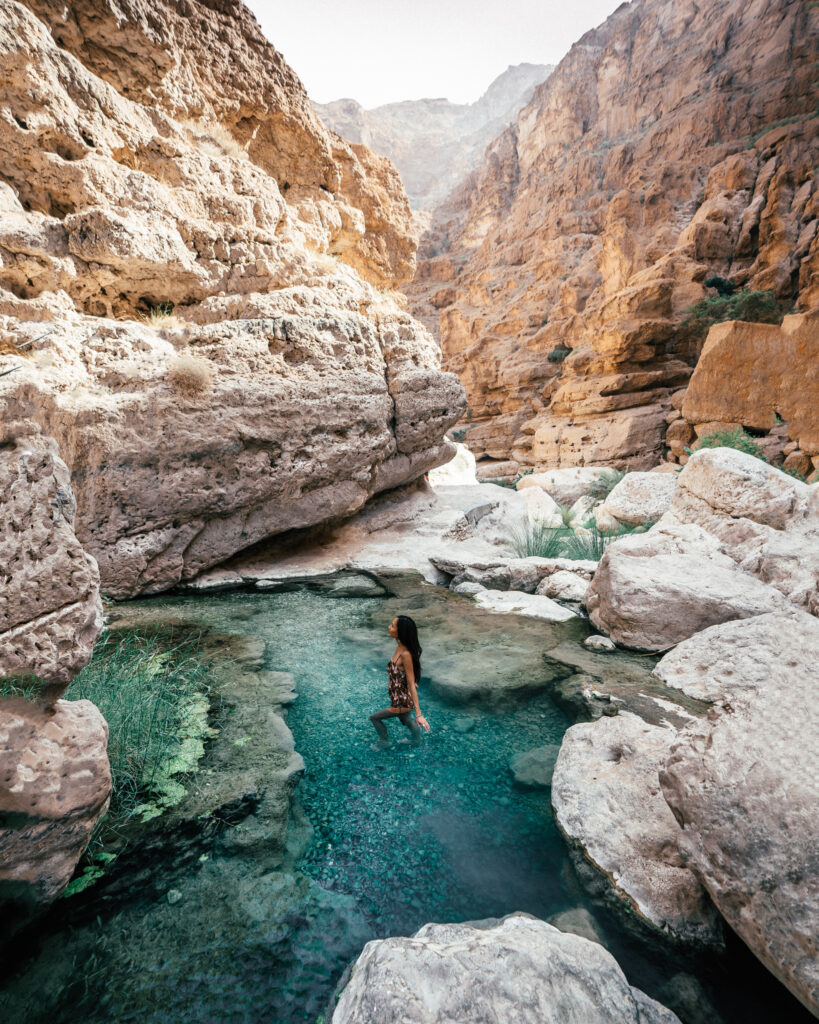
We found an emerald pool on the hike into Wadi Shab.
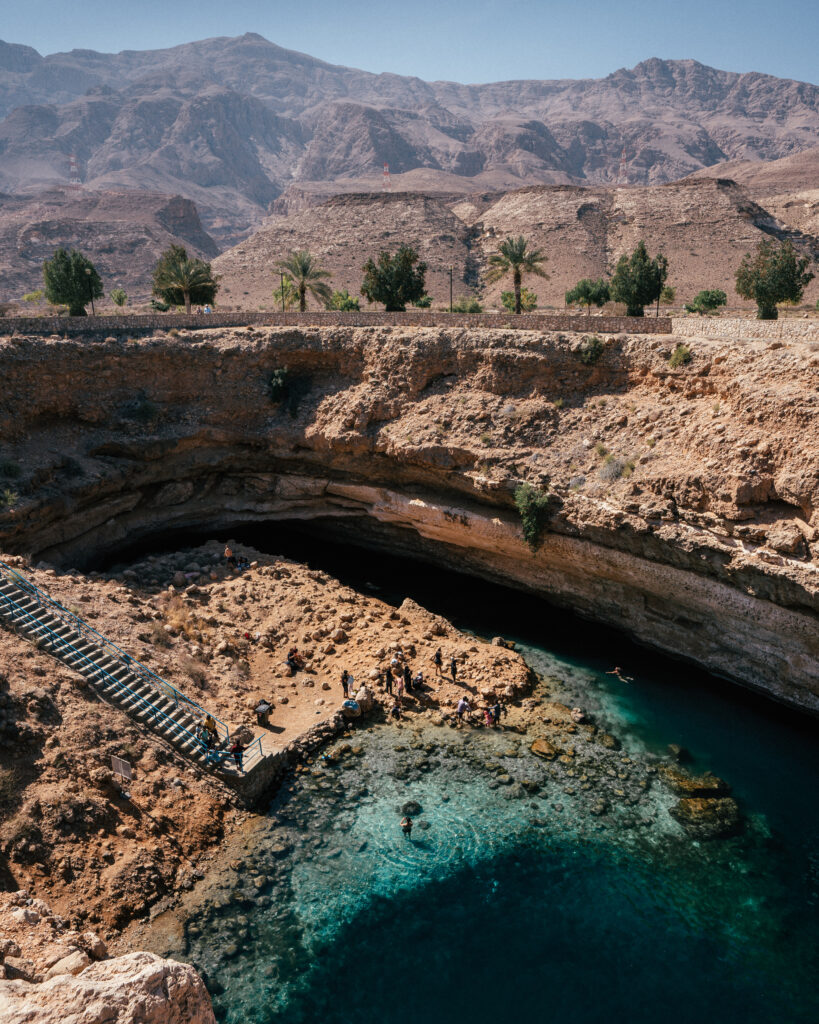
Bimmah Sinkhole.
EXPLORE THE WADIS, SUR & MORE
BIMMAH SINKHOLE
Perhaps the most iconic place in all of Oman, and it’s completely free to visit. The Bimmah Sinkhole is located off of Road 17, in the middle of nowhere. The otherworldly limestone pool is filled with a mix of both fresh and sea water that together create a stunning shade of deep turquoise sparkles. Visitors reach the pool via a cement staircase where they throw their things on a rock and then enjoy swimming in the clear waters that plunge to 20 meters in depth.
SUR
Sur is a city, not a natural wonder. But it’s worth the detour if you’re passing through this part of Oman. The coastal city is home to bright white buildings, boat yards, forts, towers and a lighthouse, all perched over the Gulf of Oman.
WADI AL ARBEIEEN
Gorgeous wadi located in Oman’s Al Sharqiyah region, but only reachable with a 4WD vehicle. From the parking lot, it’s five to six hours (roundtrip) of hiking, rock scrambling and swimming to reach Wadi Al Arbeieen. Trekkers that make the journey will enjoy stunning blue pools of water, waterfalls, cliff jumping and soaring rock formations.
WADI BANI KHALID
A stunning tropical oasis, and one of the easiest wadis to reach. A 90-minute drive from Sur, Wadi Bani Khalid’s large emerald pools sit surrounded by orange and brown rocks. This is one of the only wadis with facilities (a restaurant, bathrooms and benches) and no hiking required, making it a popular destination for locals. It can also be visited as a day trip while staying in the desert.
WADI SHAB
This is the most famous wadi in Oman. The trailhead sits on the side of Road 17. There is a large parking lot with bathrooms and one small restaurant. Arrive early to get a parking spot. The journey out to Wadi Shab begins with a short two-minute boat crossing, and the earliest you can cross is 7 AM. Then, it’s a 1.5km hike through the gorge to the canyon’s main natural pools. The hike is easy, and takes about an hour in each direction. When you reach the flooded gorge, the only onward option is to swim.
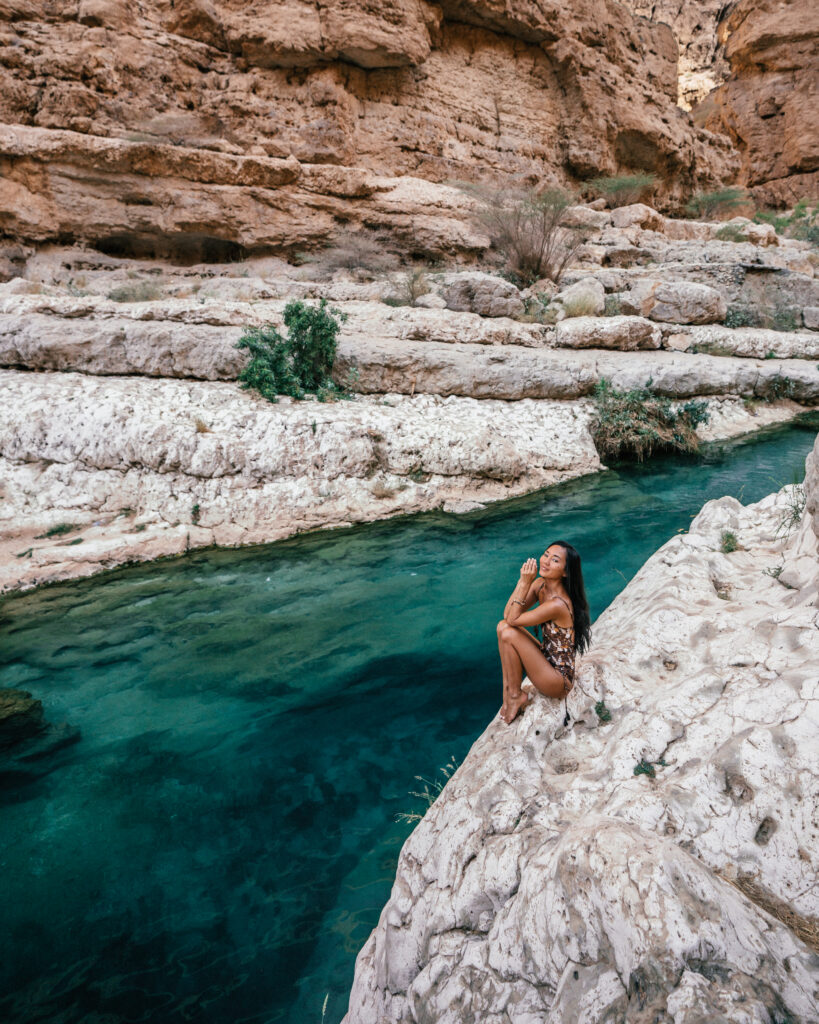
Wadi Shab is a narrow canyon filled with clear blue water that visitors swim through (since there is no trail).
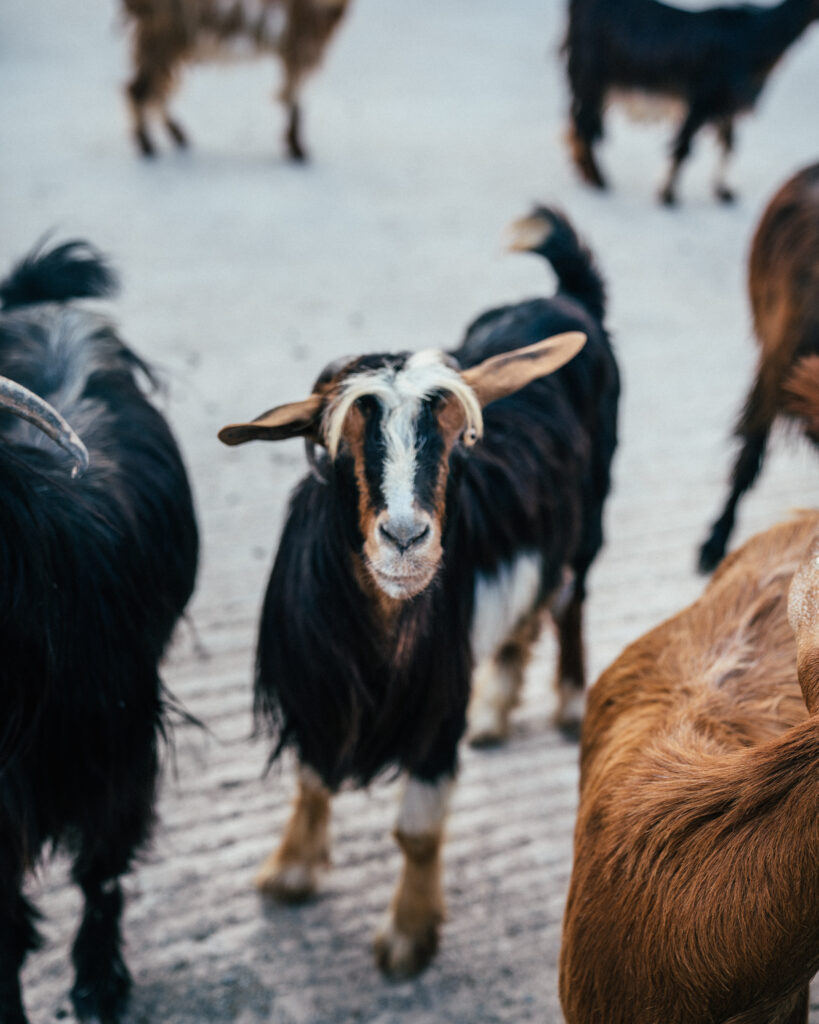
Dozens of goats surround our car in the Wadi Shab parking lot. I wanted to bring all of them home!
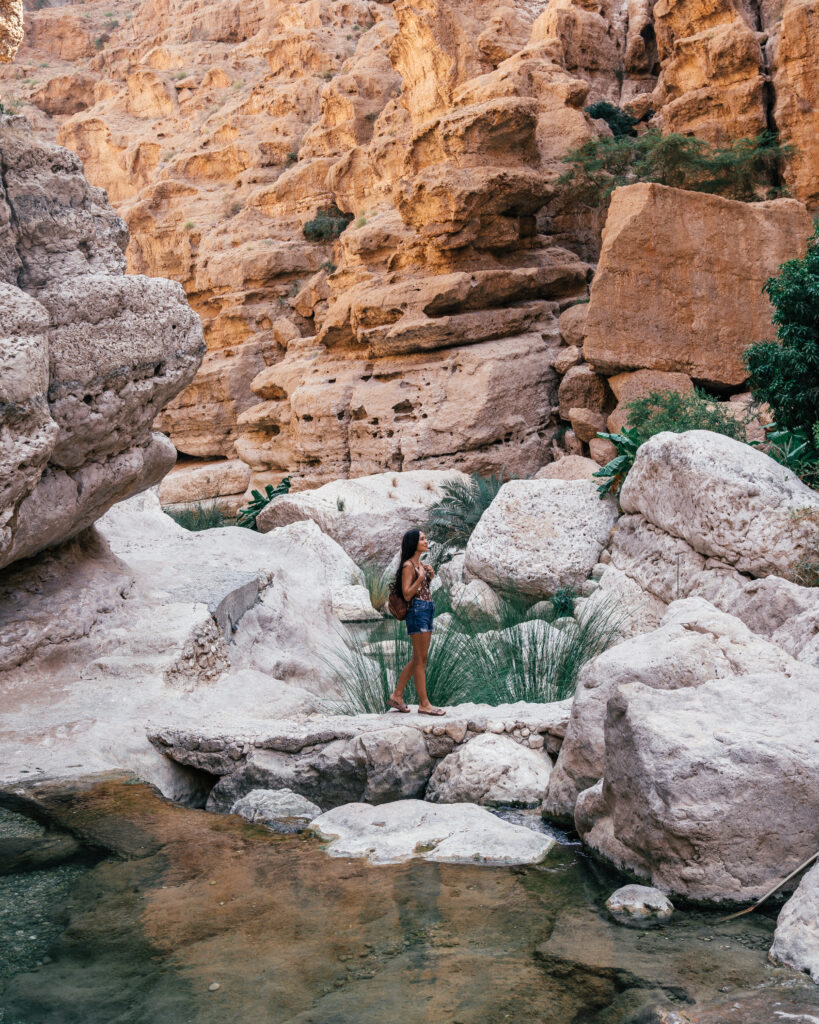
The hiking trail through the canyon is stunning – towering orange rocks, crystal turquoise pools of water and loads of green fauna.
WHERE TO STAY
Lodging options in this region of Oman are pretty dismal – there’s nothing I can recommend in good conscience. My best suggestion is to plan day trips from Muscat, and then on the day you journey from Muscat to Wahiba Sands, stop at a wadi and Sur along the way.
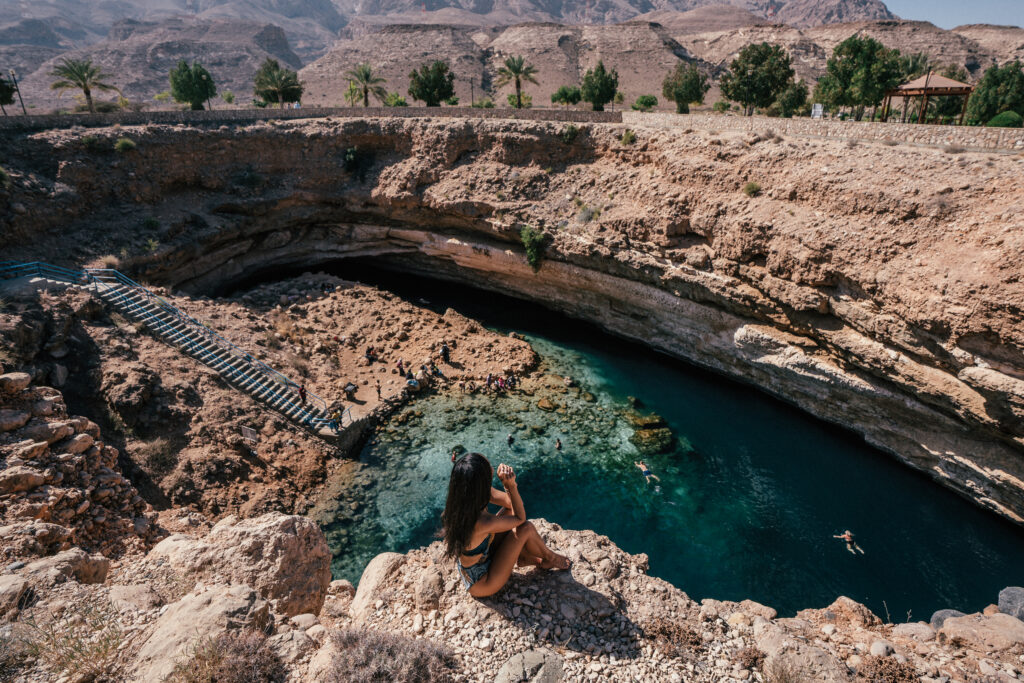
Watching the swimmers at the Bimmah Sinkhole before hopping in myself.
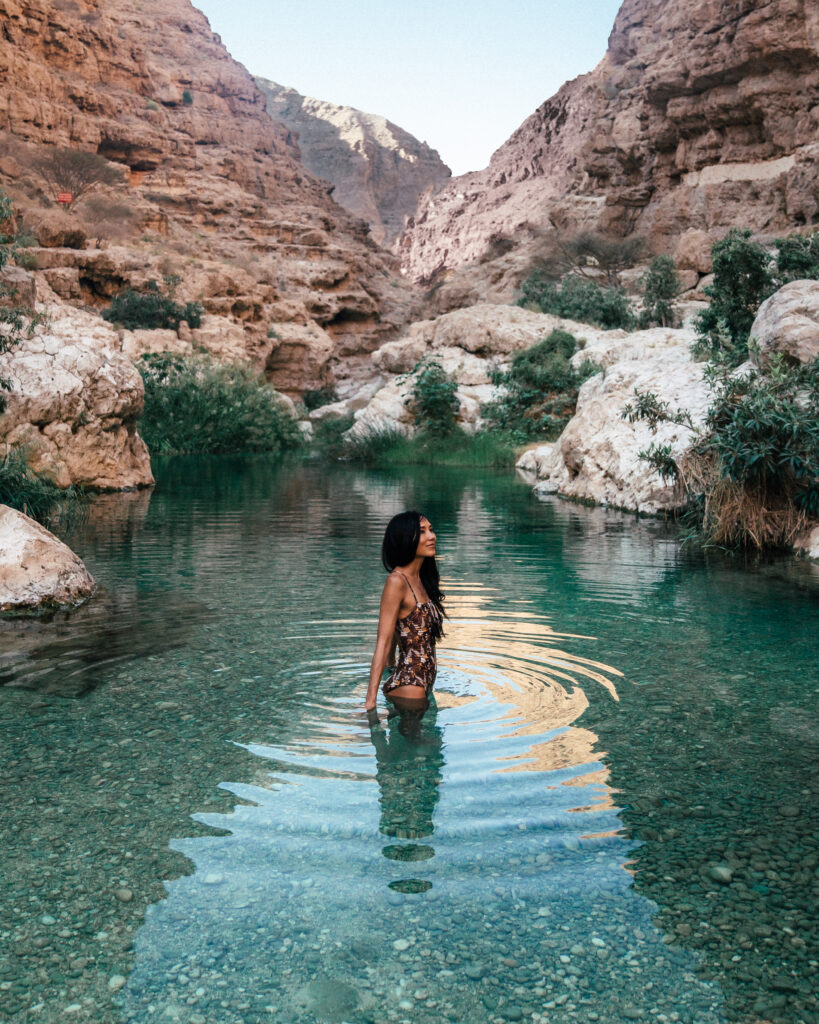
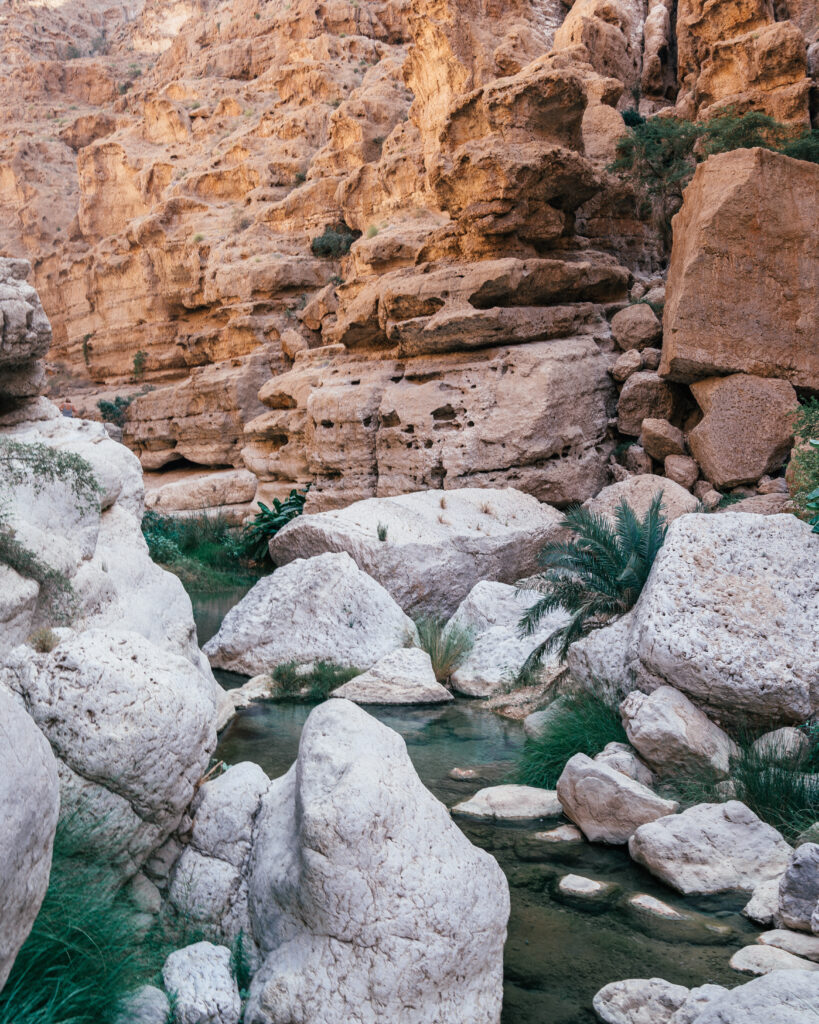
The hiking trail to Wadi Shab.
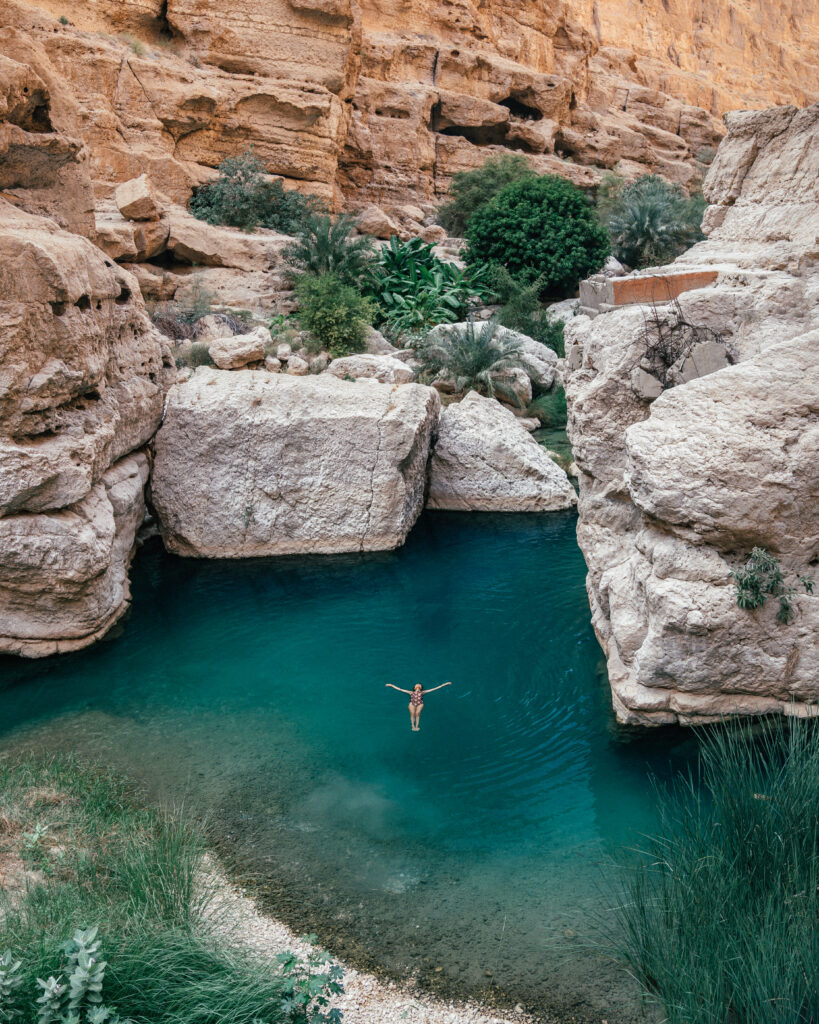
Mirage feels.
WAHIBA SANDS
day 6
A trip to Oman wouldn’t be complete without a visit to the desert. The spectacular dunes of Wahiba Sands are an easy addition to any itinerary, a mere three hours driving from Muscat. A night or two in a desert camp under the stars is a pretty surreal experience, and the scenery is spectacular – vast dunes, sand ripples, wild camels and Arabian style carpets.
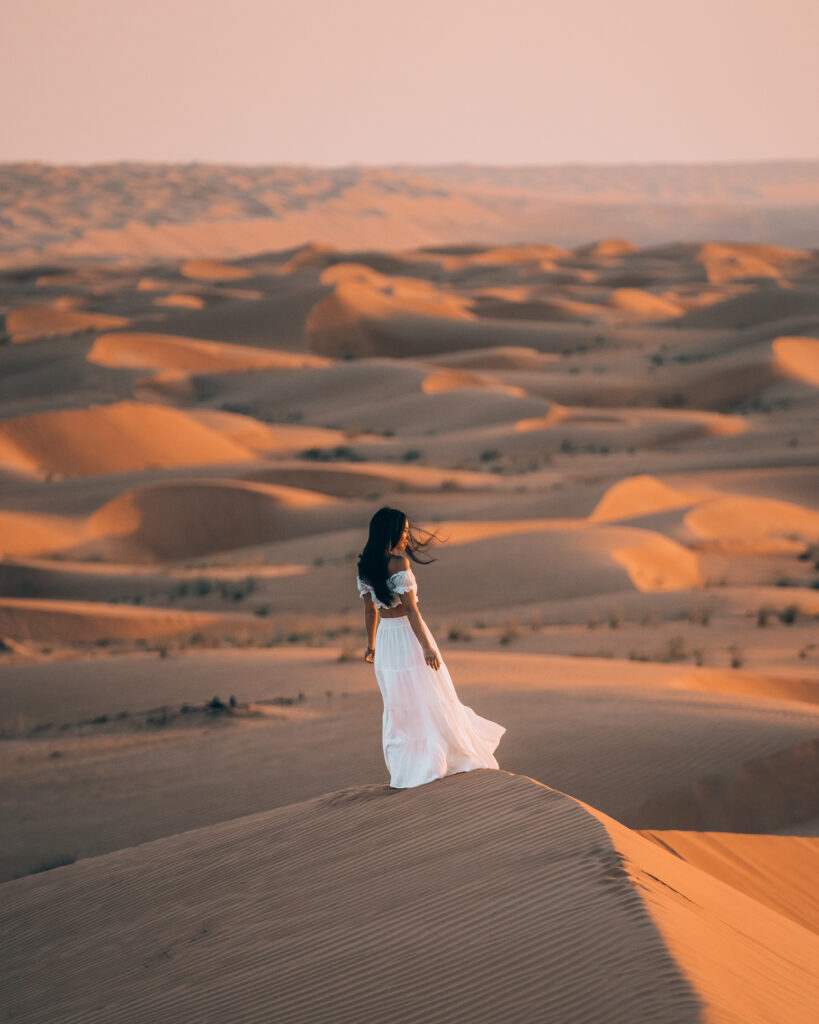
Sunset in the sand dunes of Oman’s majestic desert.
WAHIBA SANDS TRAVEL TIPS
- The desert cools off in the evenings, pack a sweater.
- If you’re attempting to climb a dune for sunrise or sunset, give yourself extra time. It take twice as long (and twice the energy!) to climb the mounds of sand.
- Driving in the desert can be overwhelming. If that’s the case, most camps will meet you in a nearby town and either: 1. Lead you through the desert to your camp 2. Drive you to your camp (you can leave your car parked in town). We opted for the second option.
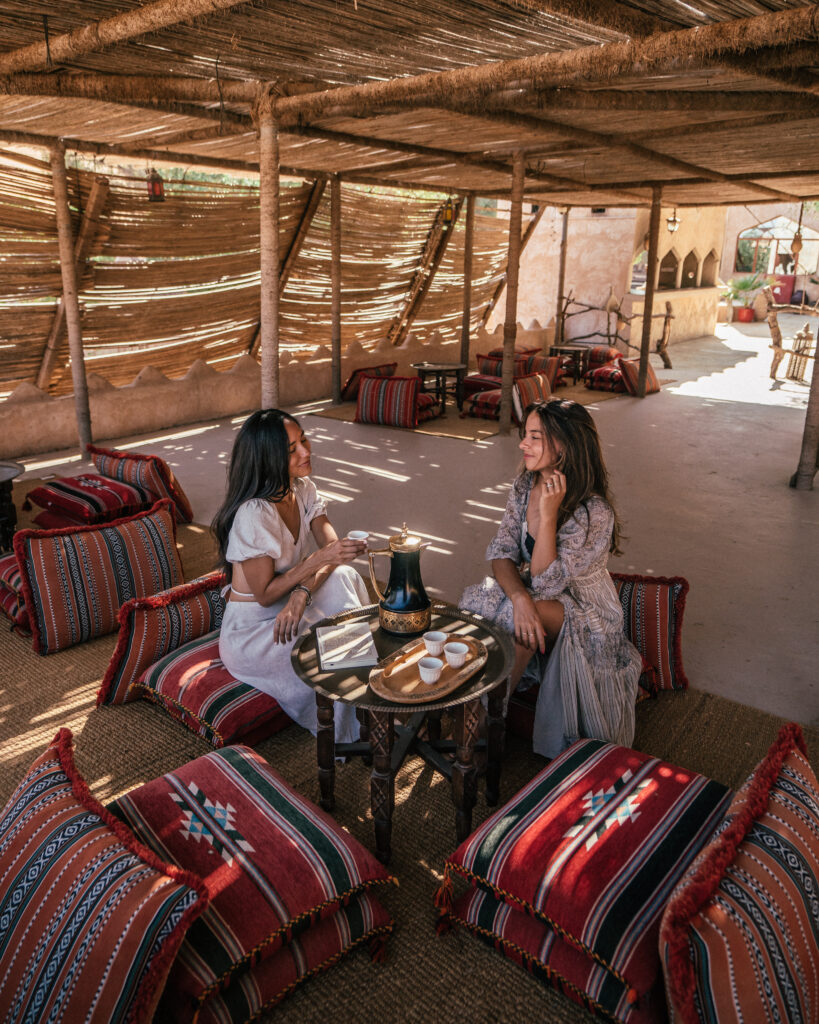
Tea time at our remote desert camp, Thousand Nights Camp.
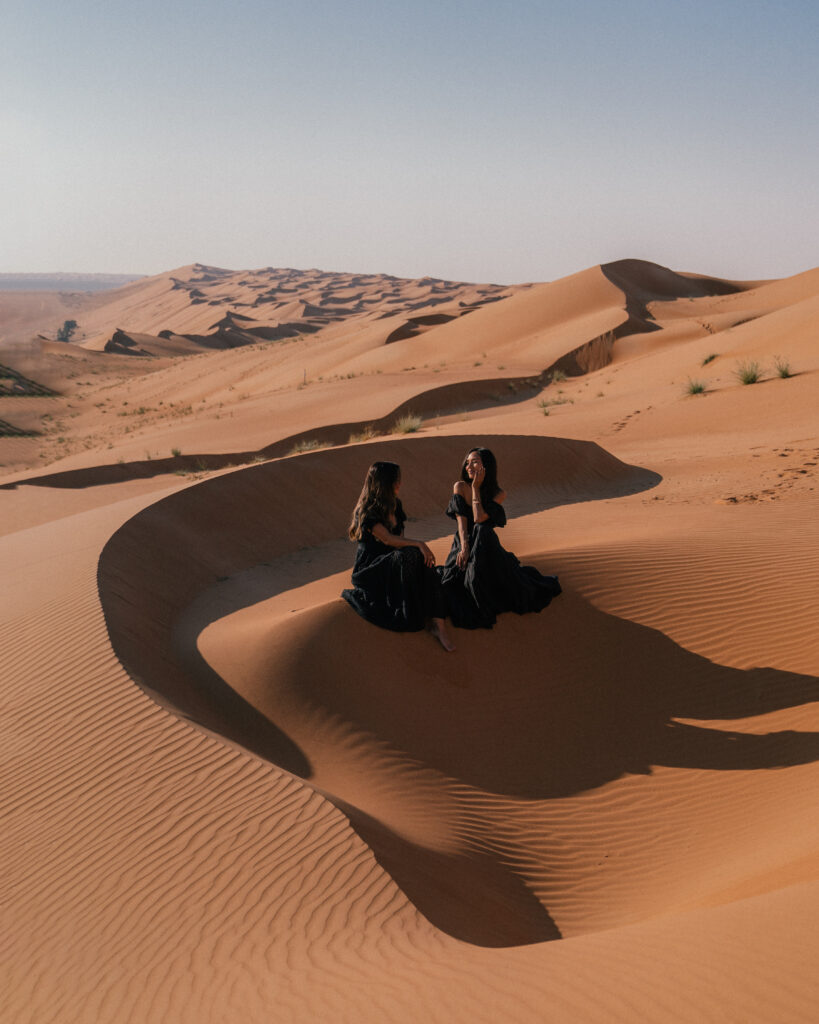
All the Dune vibes here in the Omani desert.
EXPLORE WAHIBA SANDS
4X4 DUNE BASHING
Strap into a 4×4 vehicle for a wild ride in the desert with an experienced Bedouin driver climbing and then flying off sand dunes at heart-pumping speeds.
DESERT DRIVE
Book a drive through the desert with scenic stops for spectacular views of epic dunes, desert camps and even wild camels. Golden Hour is a particularly nice time for a desert drive.
QUAD BIKE RIDES
Hop on a quad bike and follow your guide on a thrilling ride across rolling desert dunes.
SAND BOARDING
Similar in concept to snow boarding, adrenaline seeking visitors can hop on a sand board at the top of a dune and glide their way to the bottom.
SWIMMING
A handful of the desert camps have pools, a relaxing escape from the the midday heat.
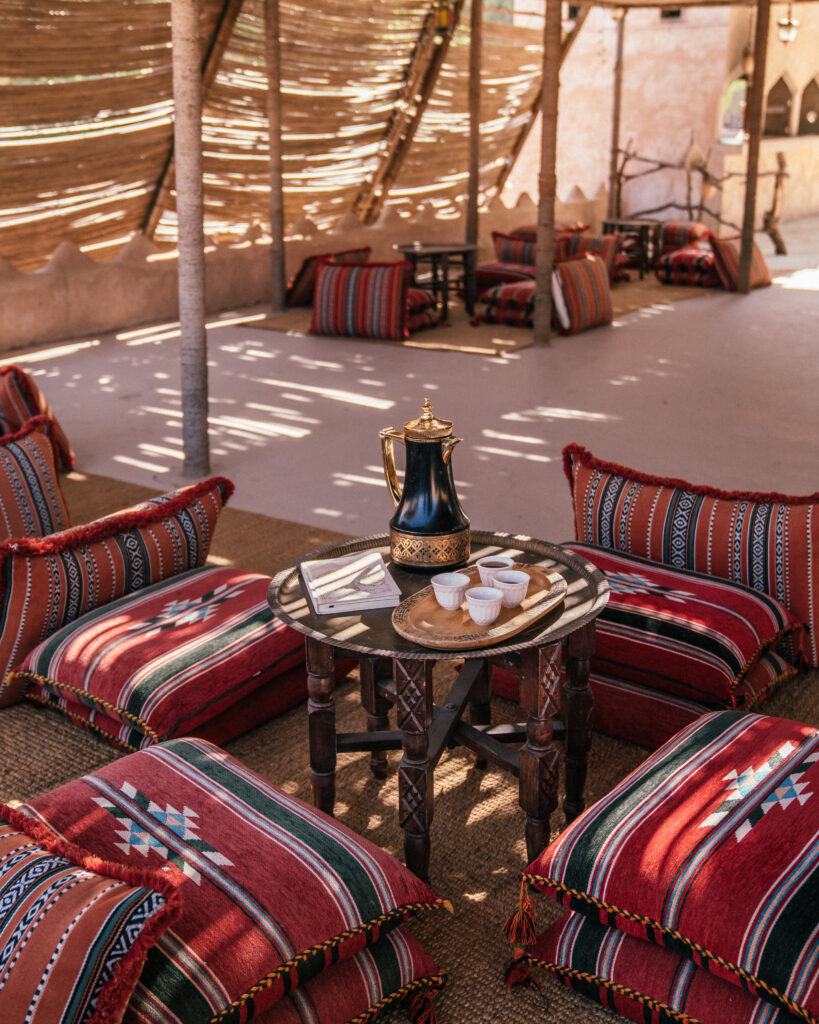
Cheers to tea time!
WAHIBA SANDS DESERT CAMPS
Desert Nights Camp is the prettiest desert camp in Oman. More than 50 white Boho styled tents sit in the middle of the desert offering the most picturesque view from the top of its local dune. Tents are equipped with air conditioning, along with a restaurant and spa facilities at the camp.
Luxury Desert Camp offers guests the chance to stay in Mars-style domes in the middle of the desert, perfect for star gazing. A stay here feels a bit more disconnected than the other larger camps where you’re surrounded by other tents and facilities.
At Thousand Nights Camp, guests stay in traditional Bedouin wool tents equipped with twin beds, a table, chairs, air conditioning and a private open air bathroom. The lobby is housed in a picturesque structure that looks like a desert castle. Facilities on site include a restaurant, pool and outdoor movies under the stars in the evenings.
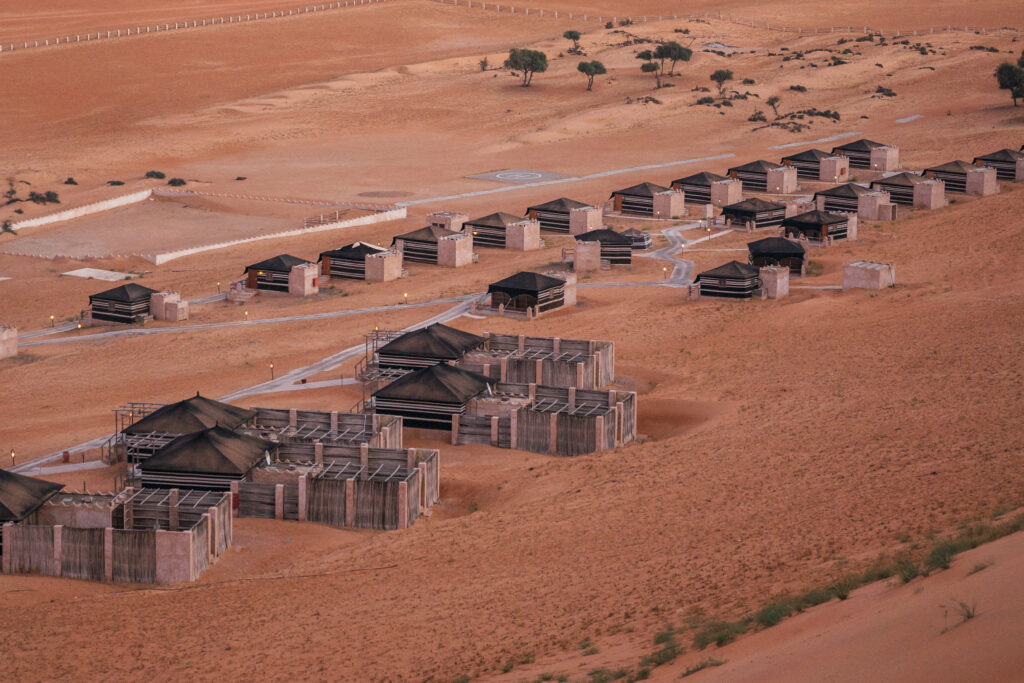
We stayed in one of these desert tents at the Thousand Nights Camp.
NIZWA & JEBEL AKHDAR
day 7-10
Nizwa and Jebel Akhdar are driving distance from Muscat, and can certainly be visited as a day trip for visitors based in the capital city. If time permits, I highly recommend a stay in the mountains, and exploring the mud villages, desert castles and forts of Nizwa with Jebel Akhdar as a home base. A mountain stay is unlike anywhere else in the region, and a completely serene conclusion to a road trip through Oman.
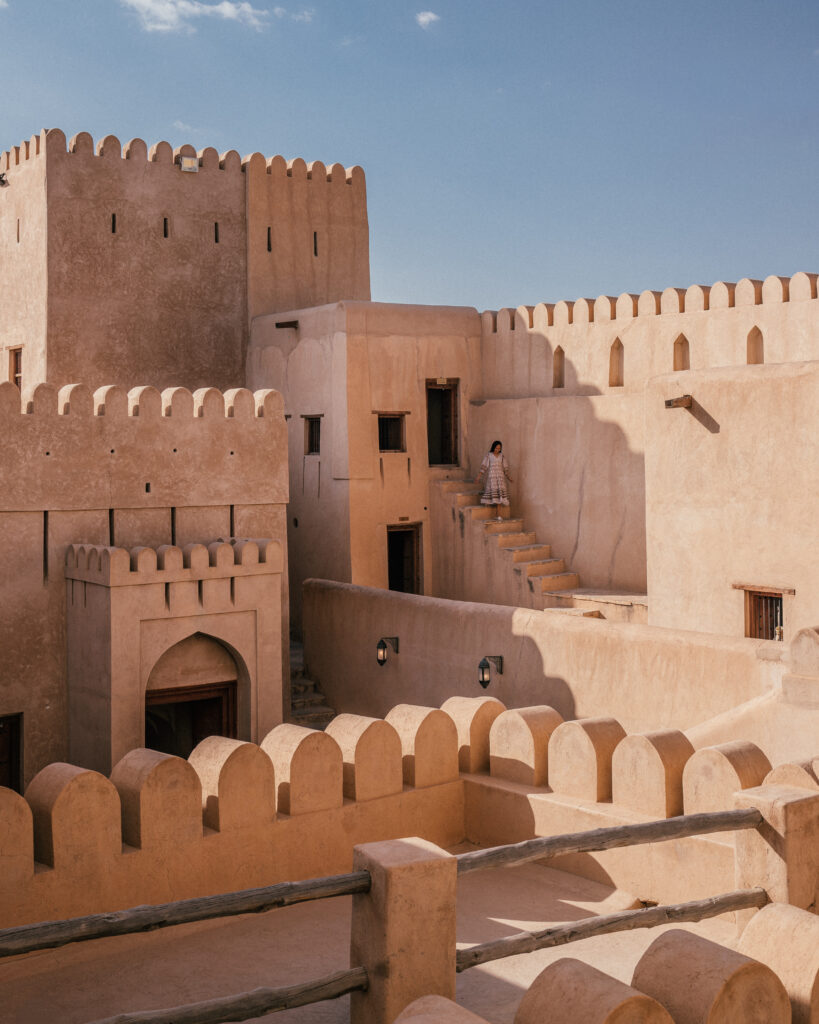
The dreamy Nizwa Fort is one of the prettiest places I visited in Oman. Outfit details: Daughters of India dress linked here.
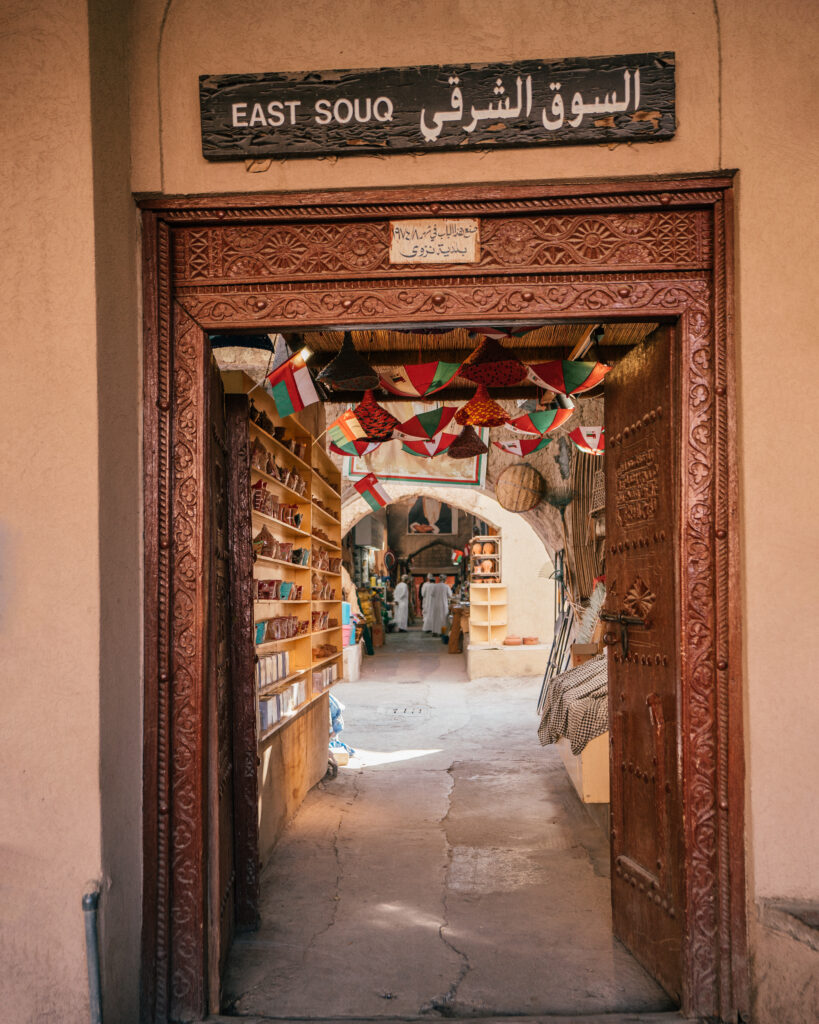
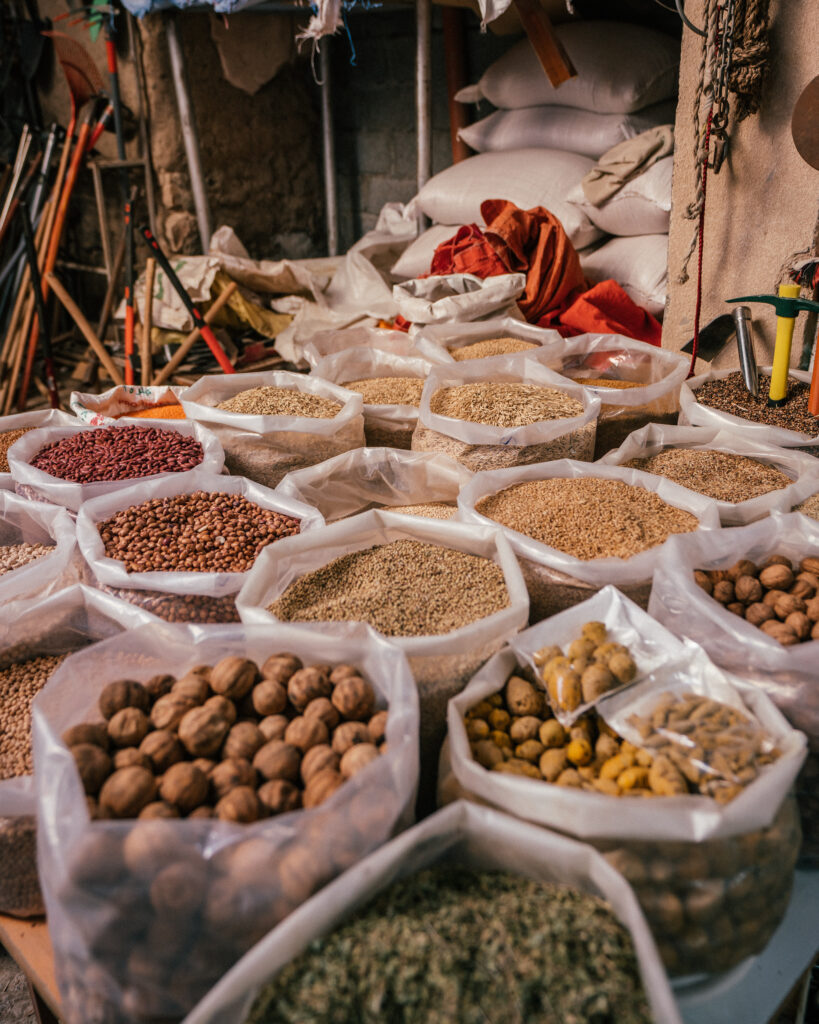
Nizwa Souks.
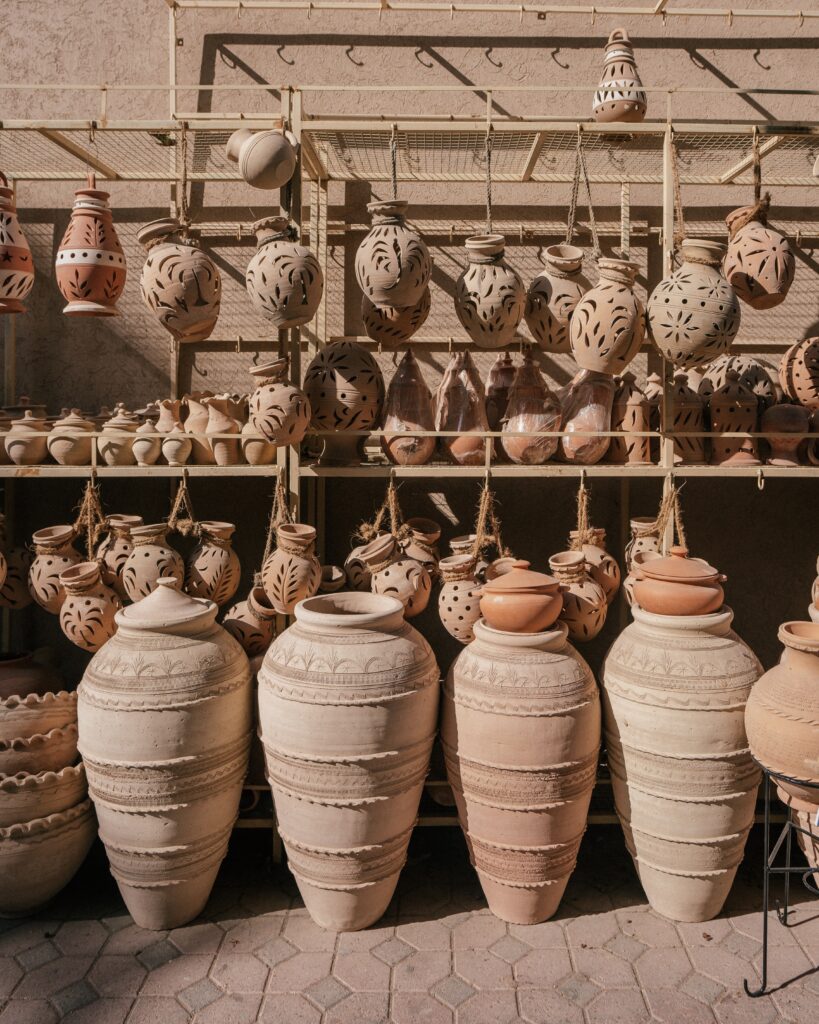
The Nizwa Souks are filled to the brim with beautiful pottery.
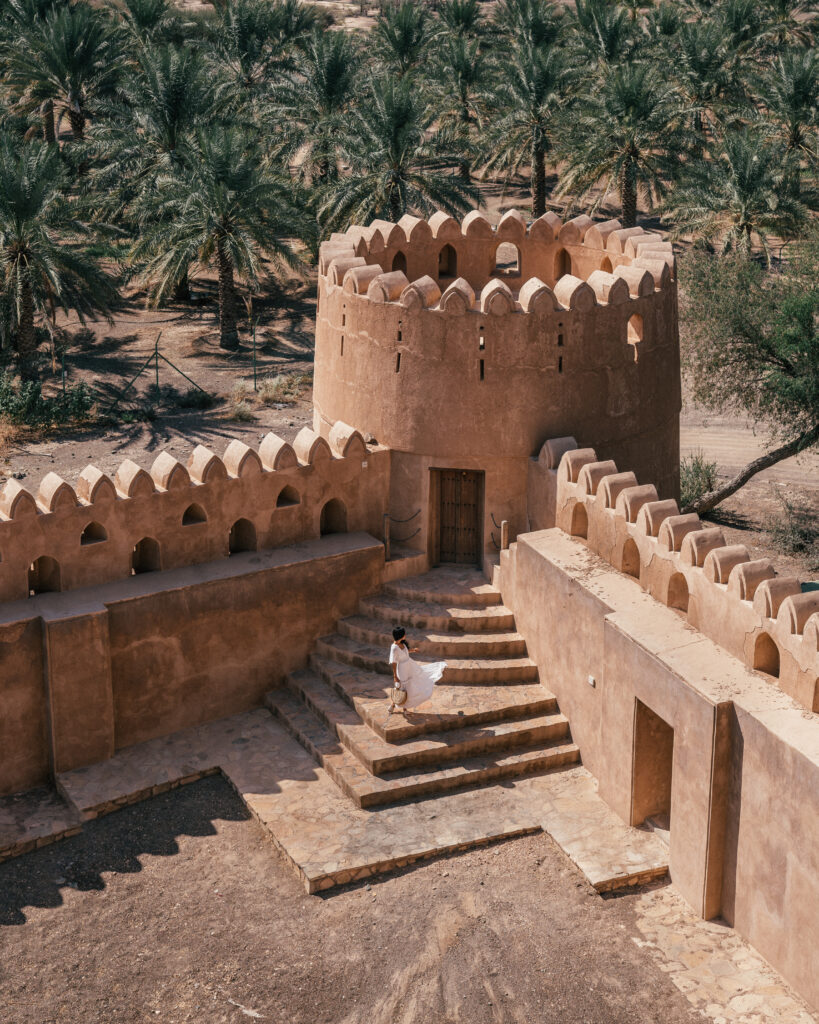
Jibreen Castle.
EXPLORE NIZWA & JEBEL AKHDAR
AL HAMRA MUD VILLAGE
A quiet abandoned mud village that sits at the base of the Hajar Mountains, surrounded by an oasis of date palms. Al Hamra is easy to explore on foot, and it’s likely you’ll have the place to yourself. The brown mud houses are incredibly picturesque, as are the occasional bright green and teal doors that serve as gateways to the village’s only occupied structures.
BAHLA FORT
The sweeping Bahla Fort is one of Oman’s only UNESCO World Heritage Sites, boasting impeccably restored mud walls, towers, wells and a mosque. There are stunning viewpoints of the fort from the surrounding village, and tourists can explore inside as well.
BIRKAT AL MOUZ VILLAGE RUINS
Another abandoned mud village that sits at the base of a mountain, surrounded by an oasis of date palms. The best viewpoint is from the hill opposite the village, at the base of the tower.
JEBEL AKHDAR & JEBEL SHAMS
The incredible mountains, peaks and canyons located east of Muscat can certainly be visited as a long day trip, but best to book an overnight stay to truly appreciate the serenity of the epic setting. Popular stops include the spectacular Whadi Ghul, the Grand Canyon of Oman, as well as hiking Wadi Bani Habib.
JIBREEN CASTLE
One of the prettiest sights in Oman that has all the feels of India and Morocco. Jibreen Castle looks straight out of a desert fairytale, home to fortress walls, open courtyards, riad-style chambers, decadent wood balconies, ornate windows and picturesque towers. A must visit.
NIZWA FORT
Another gorgeous Omani castle, Nizwa Fort might be my favorite spot in all of Oman. The 17th century structure is perfectly restored, and feels like stepping into another world. Visit midday, and you’ll likely explore the fort’s expansive towers, passageways, bridges, staircases, rooftops and courtyards with no one around. Most tourists show up at sunset.
NIZWA SOUQS
Located just outside the walls of the Nizwa Fort, you’ll find the dreamy Nizwa Souqs. This tiny market is the oldest in Oman. The outer souq is a beautiful blur of ornate pottery, and the inner souq is filled with more traditional goods, spices, teas and lanterns. This was my favorite shopping in Oman – very mellow, beautiful and a gorgeous selection of goods.
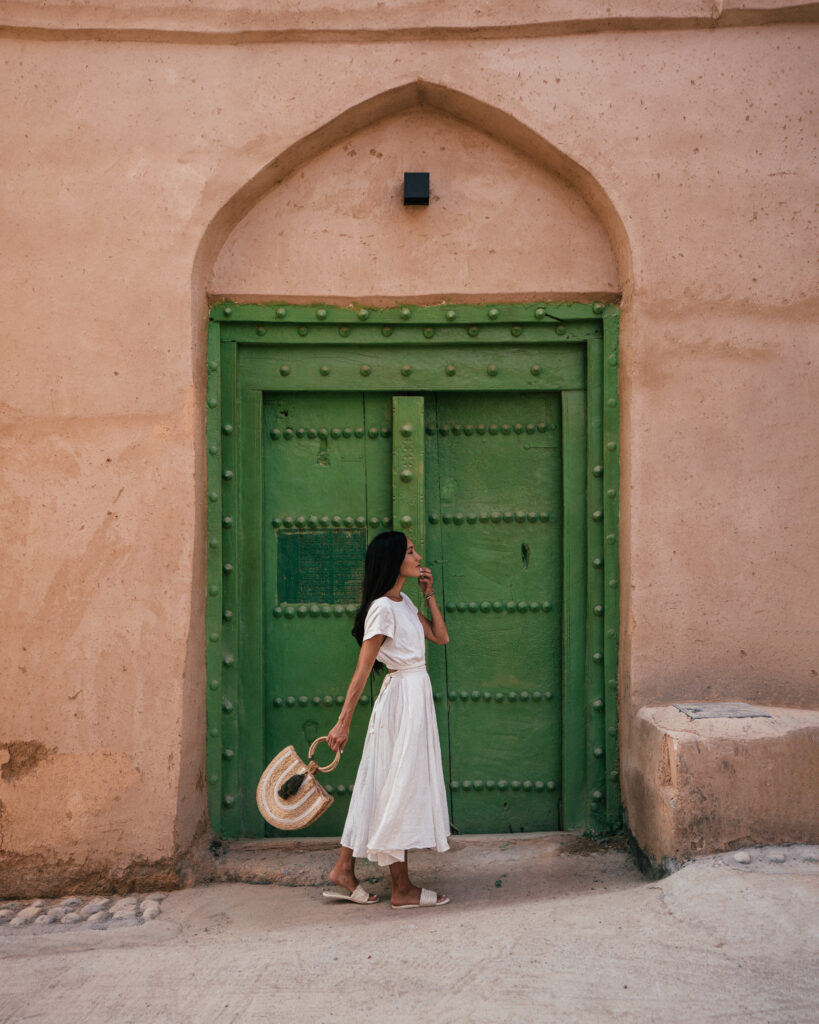
The most vibrant green door in the middle of a mud village.
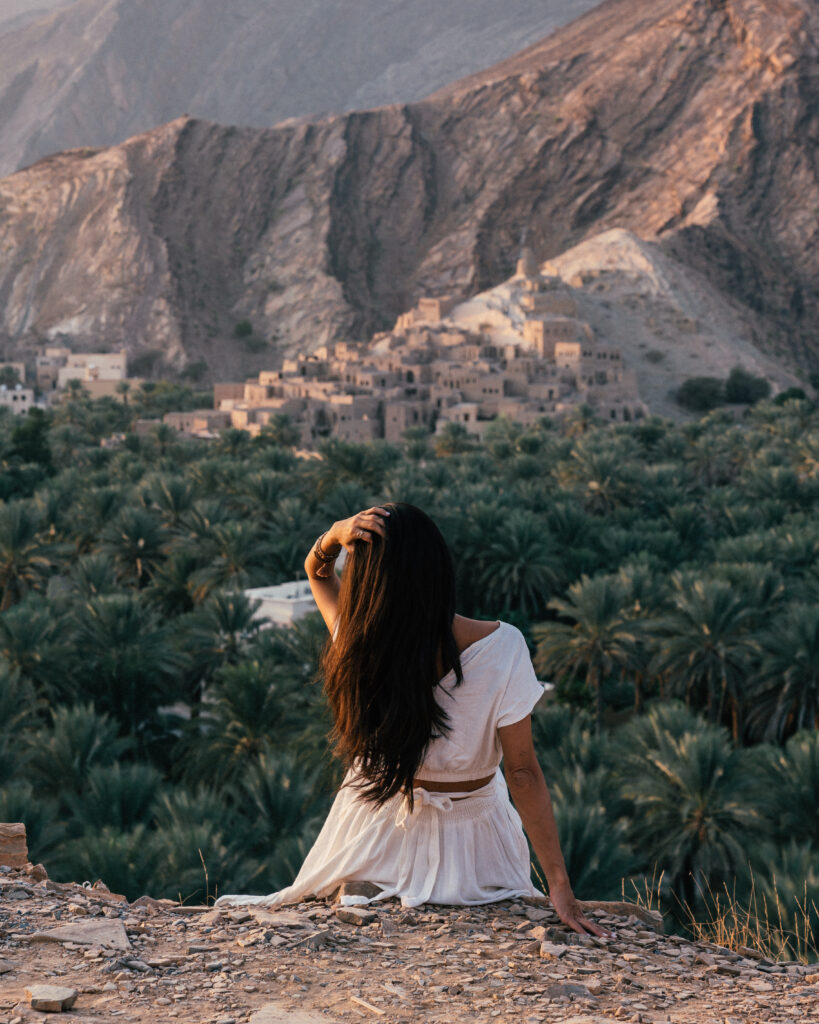
Birkat Al Mouz rises out of the palms like an oasis.
JEBEL AKHDAR HOTELS
ANANTARA AL JEBEL AL AKHDAR RESORT
A sprawling five-star retreat set high up in Jebel Akhdar, the Anantara Al Jebel Al Akhdar Resort is the perfect slow-paced end to a road trip through Oman. The rooms and villas are plush, spacious and luxurious, designed with walk-in closets, oversized bathrooms and balconies that face the mountains. There’s plenty to keep guests busy including a pool that overlooks the mountains, luxurious spa, hikes and a glass platform that extends into the canyon (great for photos). Also, the elaborate breakfast buffet is one of the best in Oman.
Another stunning resort, Alila Jebel Akhdar is a second five-star option available to travelers looking for a mountain escape. Privacy is top of mind at this property that sits perched on a cliff surrounded by dramatic views of surrounding the Al Hajar Mountains.
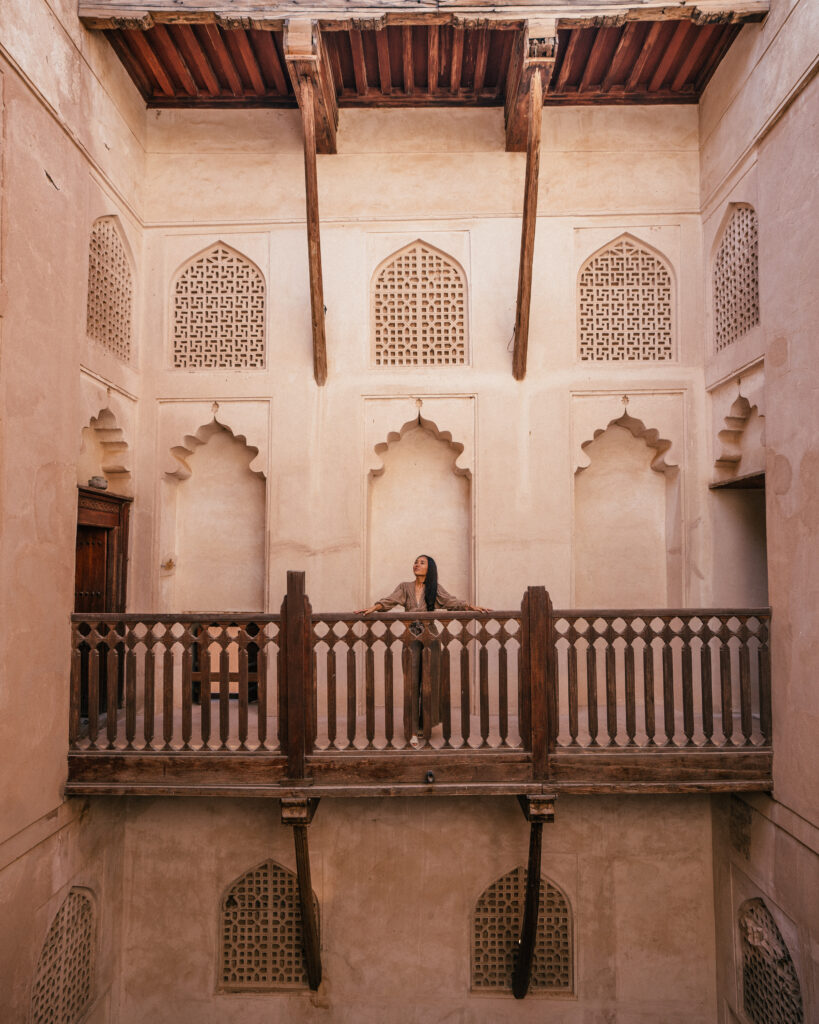
All the feels of India in Jibreen Castle.
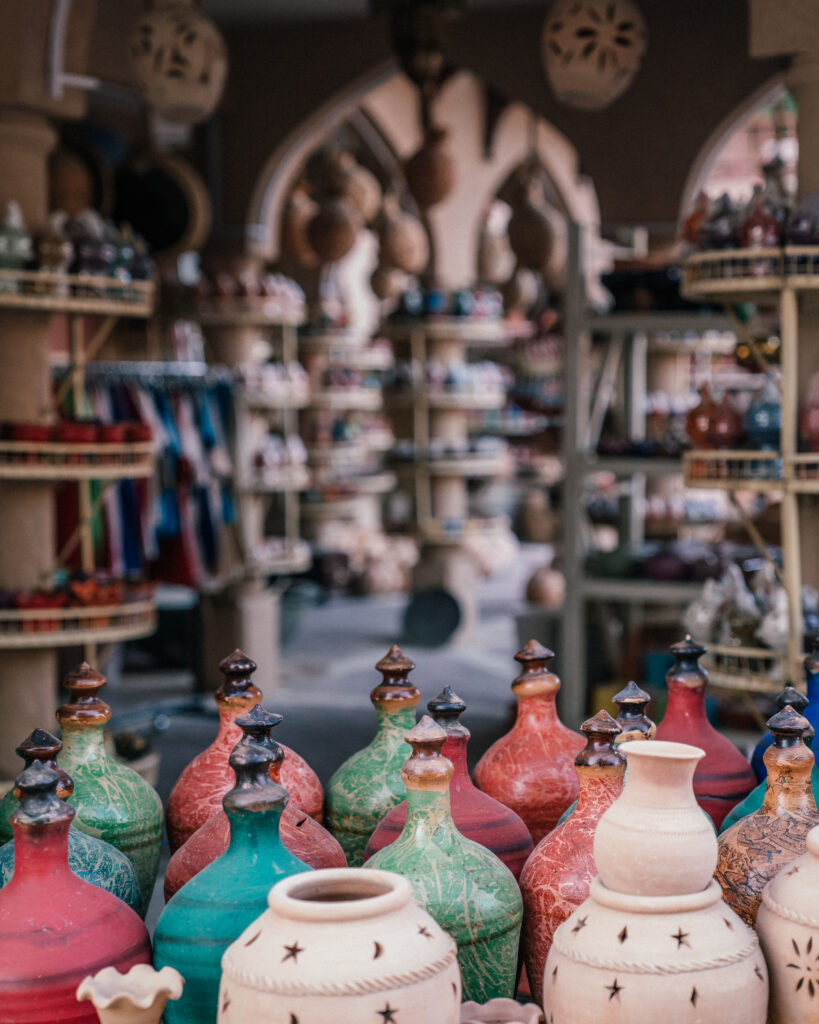
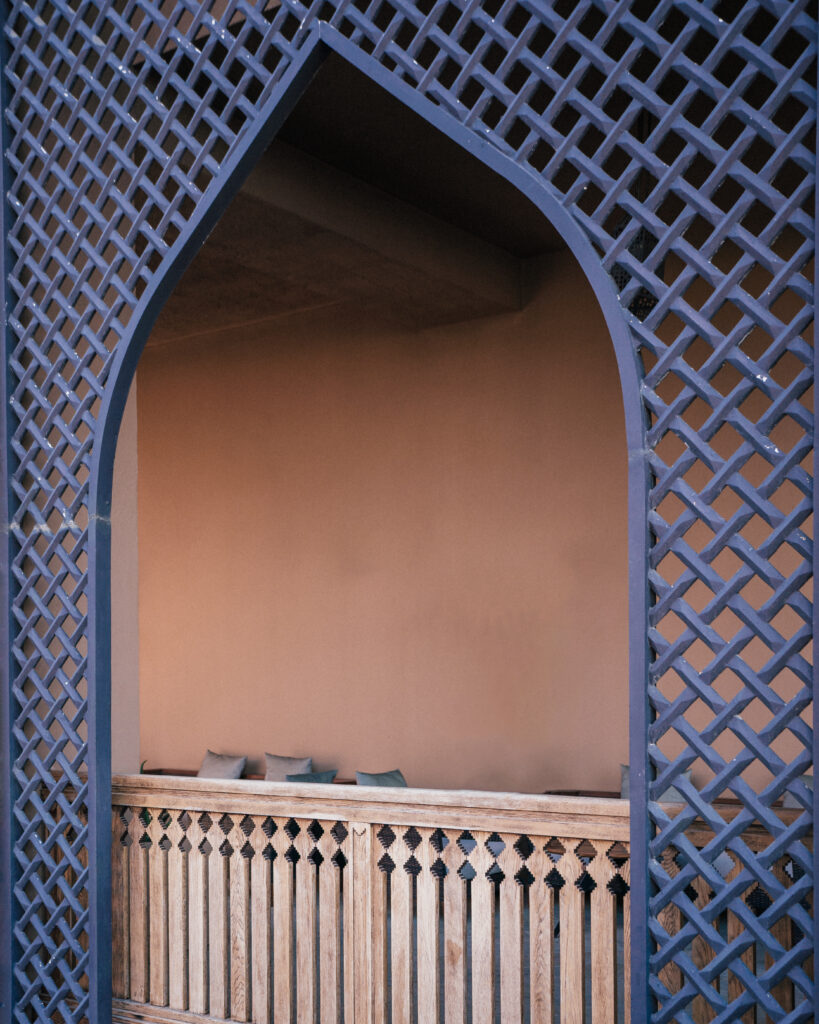
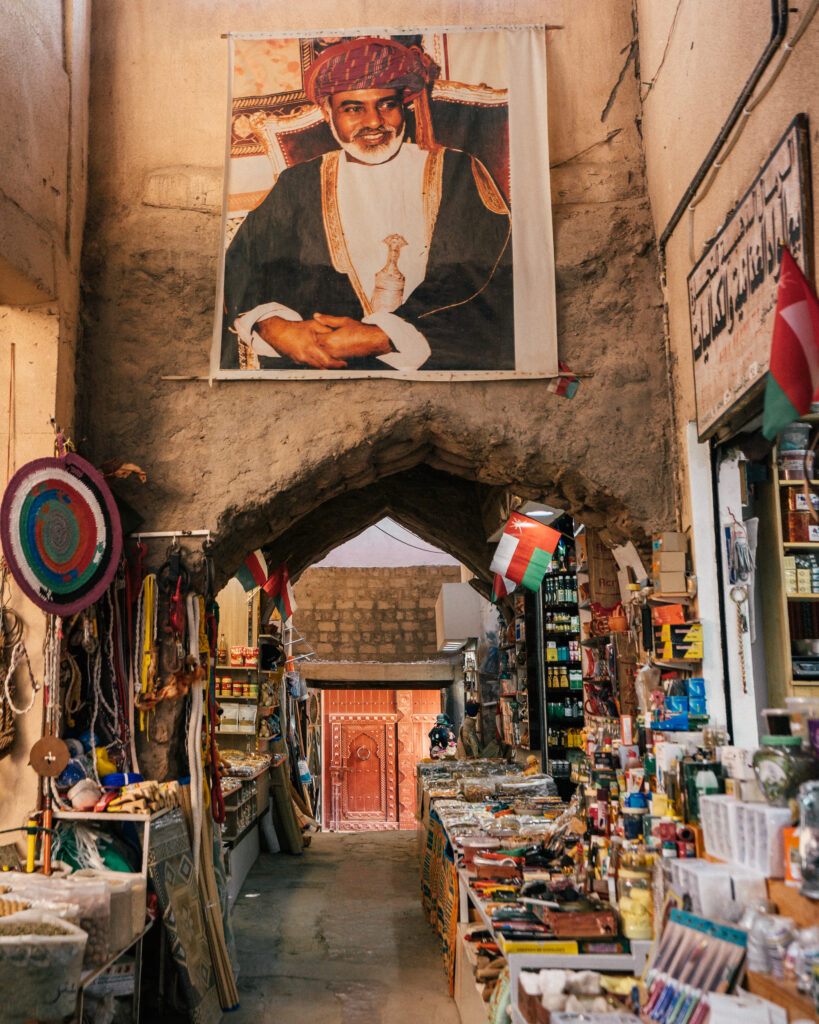
Inside the Nizwa Souqs.
GET AROUND OMAN
Car rental is a must in Oman. While most places in this region can be visited as a day trip from Muscat, the distances are far. And driving is the only feasible way to get around. That said, driving is a breeze! The highways are wide, empty and very well maintained. And with Google Maps, it’s hard to get lost. All major car brands have rental offices at the Muscat International Airport. Note that speed radars line the highways throughout Oman, and cannot be avoided. By weary of speeding.
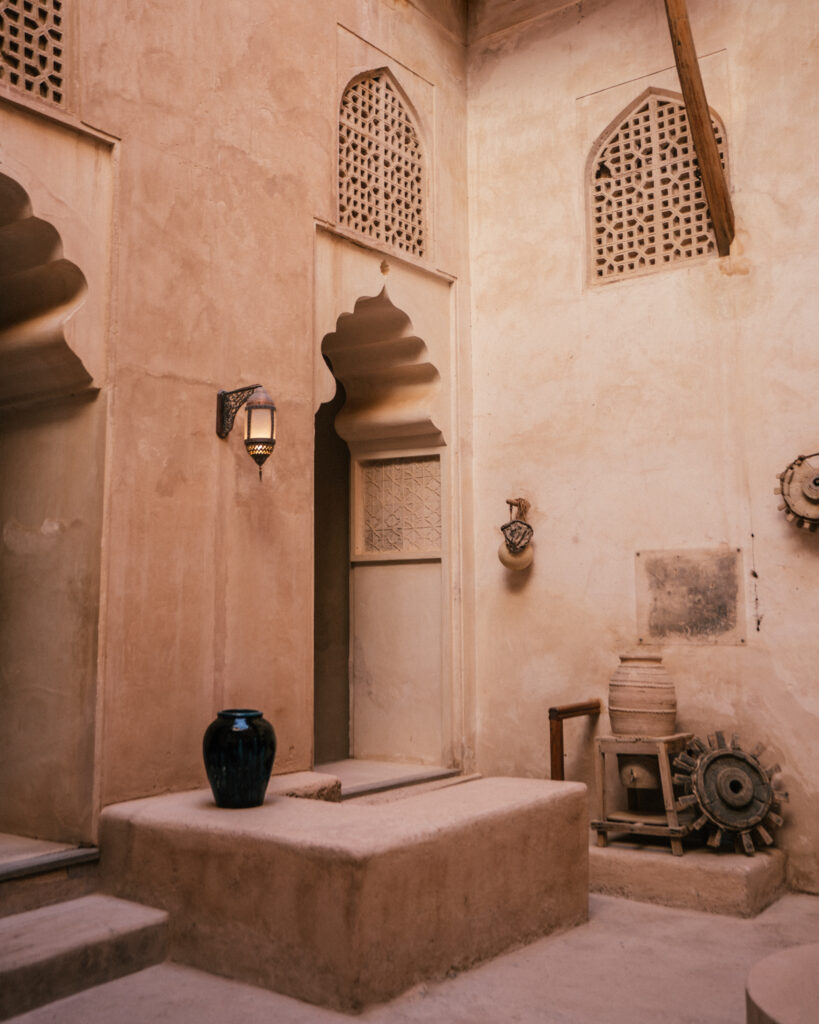
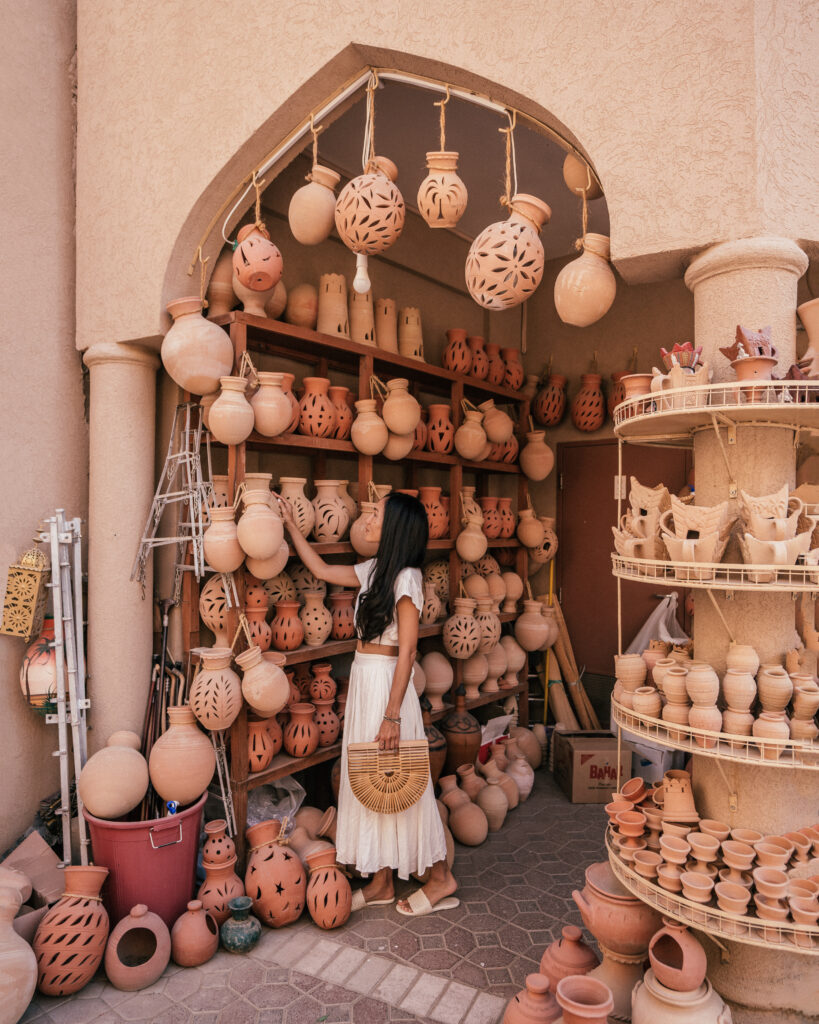
Oman is one never-ending sand castle.

Flags line the streets surrounding the Nizwa Fort.
GET TO OMAN
There are four international airports in Oman – Muscat International Airport, Salalah Airport, Sohar Airport and Duqm Airport. We flew in and out of Muscat, the hub for Oman Air. Dozens of airlines fly in and out of Muscat on limited schedules, connecting the capital city to Dubai, Doha, London, Istanbul, Cairo, Zurich, Frankfurt, Abu Dhabi, Delhi and more.

Business class flight from London to Muscat on Oman Air. Outfit details: Lounge jumpsuit linked here and slippers linked here.
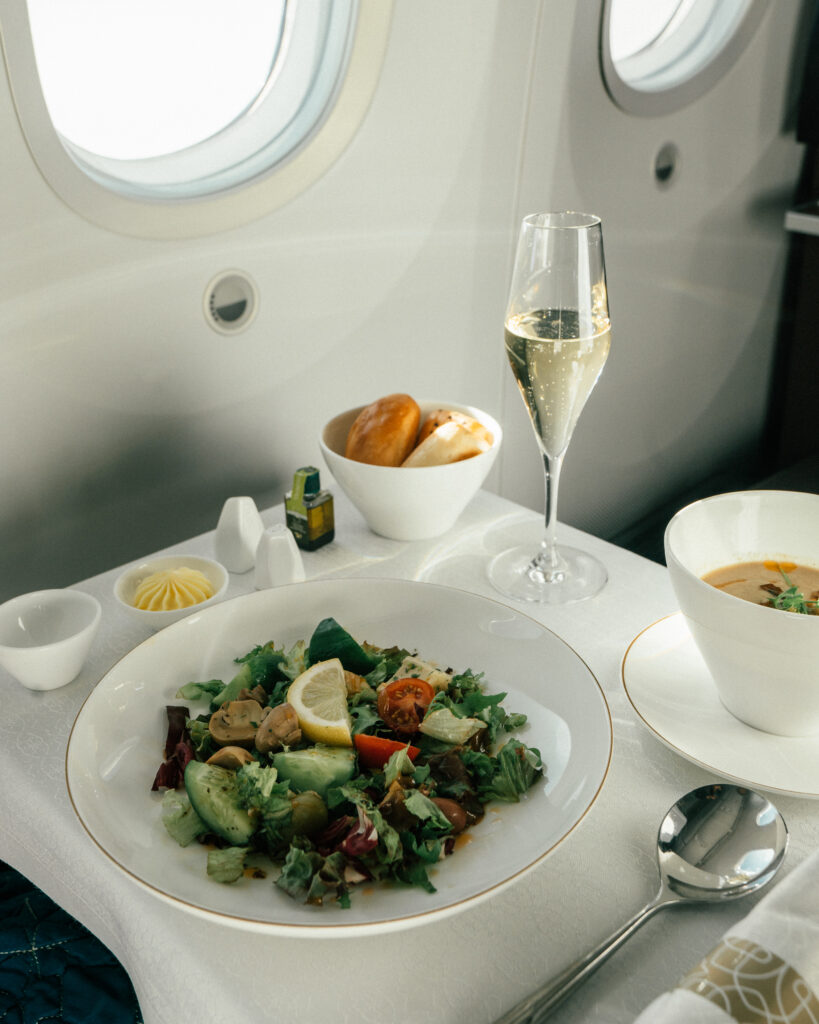
First course on the flight – soup, salad, warm rolls and sparkling wine.
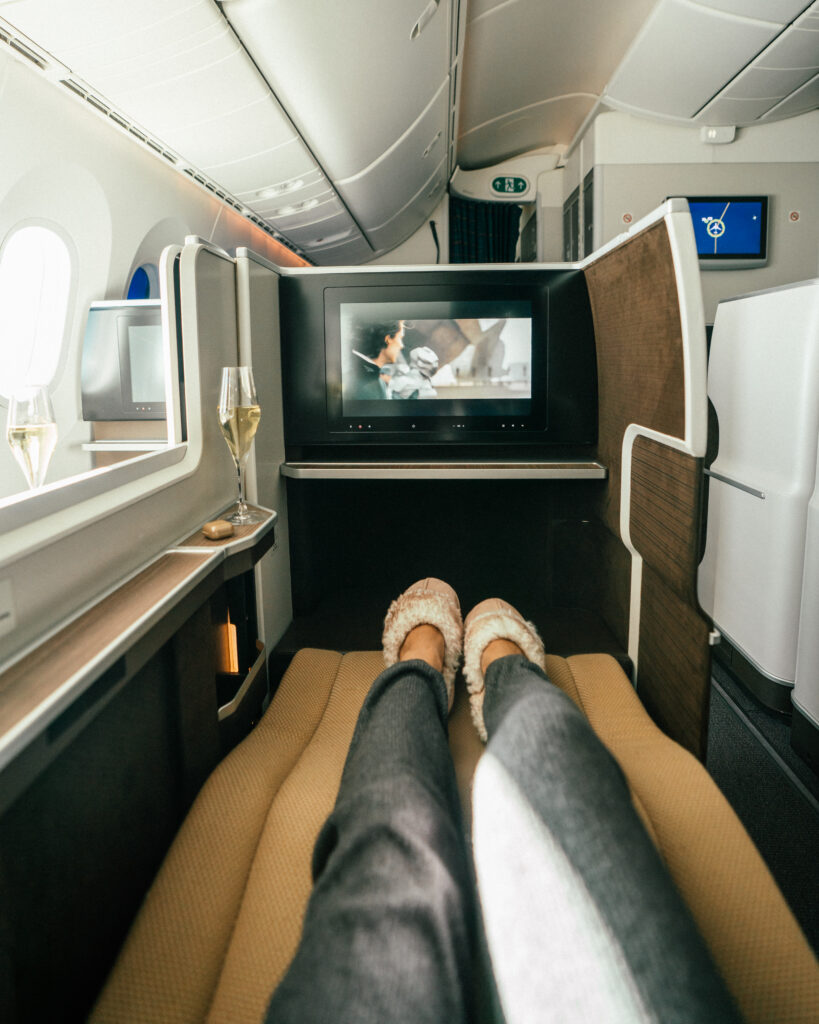
I thought it was fitting to watch Dune on the flight.
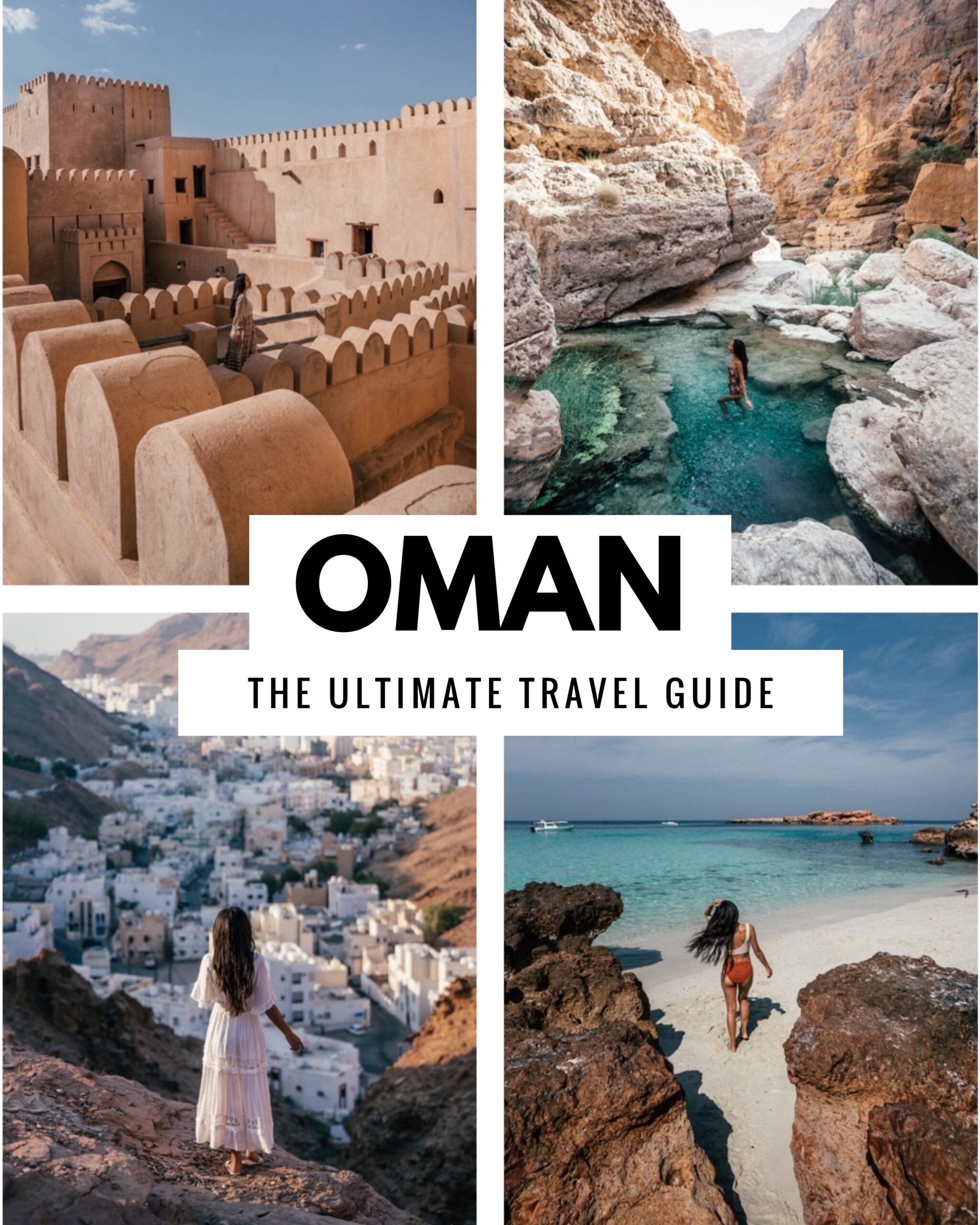
Thank you!
Hi Shelbi, thanks so. much for the recommendations. Seems like you really know how to travel to the most beautiful places. We are planning on traveling to Oman over Xmas and are not sure its the best time of the year to go. What time of the year did you go? I see that you also went to the Philippines and although I absolutely loved the country and had some good we also had ab 9 days of terential rainfall and as a result didn’t really get the same experience – we also went around January. So I’m guessing time of the year is crucial here too. Let me know your thoughts. Thanks again!
December is a great time to visit – not too hot! I went in November and thought the weather was perfect.